
- Meetings & Conventions
- Groups & Reunions
- America’s Center

- Visitors Guide
- Central West End
- Cherokee Antique Row
- Cherokee Street
- Chesterfield
- The Delmar Loop
- Downtown St. Louis
- Forest Park
- Grand Center Arts District
- Laclede’s Landing
- Lafayette Square
- Maryland Heights
- North County
- South Grand
- Webster Groves
- Architecture
- Art Appreciation
- Beer, Wine & Spirits
- Black Culture
- Celebrities
- Emblematic Eats
- Hispanic Culture
- Historic St. Louis
- LGBTQIA+ Community
- Military History
- Outdoorsy Fun
- Pet Paradise
- Sounds of St. Louis
- Traveling Teens
- Guided Tours
- Cahokia Mounds
- French Colonial Territory
- Great River Road
- Mark Twain’s Hannibal
- Kimmswick & Bonne Terre Mine
- Missouri Wine Country
- Historic Saint Charles
- Springfield, Illinois
- Underground Wonders
- Get Around St. Louis
- Transportation
- Differently Abled Assistance
- International Travelers
- Visitor Services
- Events Calendar
- Signature Events


5 Things to Do in St. Louis This Weekend | September 5 to 8
No matter your age, interests or budget, you’ll find something fun to do in St. Louis this weekend.
- 25 Things To Do in St. Louis
- Iconic St. Louis
- Live Music & Concerts
- Entertainment Districts
- Bars & Clubs
- Casinos & Gaming
- Theater & Performing Arts
- Museums & Galleries
- Sports Teams
- Sports Bars
- Shopping Centers
- Specialty Stores
- Restaurants
- Distilleries
- Wineries & Wine Bars
- Sweet Treats
- Coffee Shops
- Food Trucks
- Grocery Stores
- Specialty Food Stores
- Campgrounds
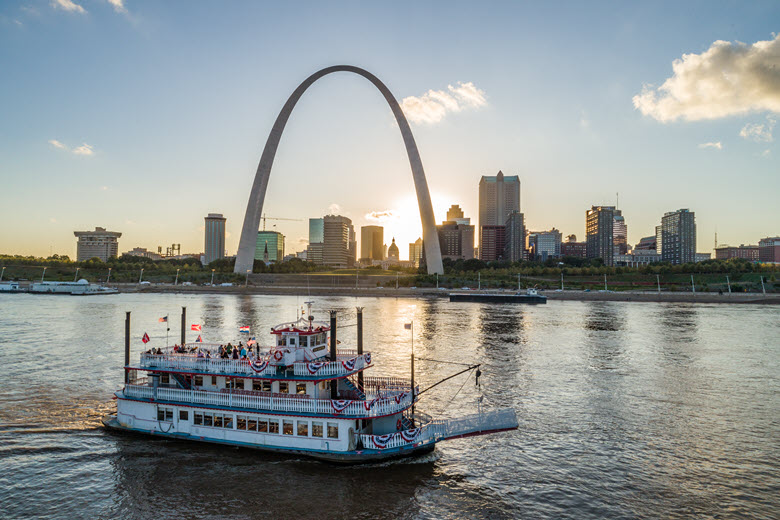
Riverboats at The Gateway Arch
50 South L.K. Sullivan Blvd. St. Louis, MO 63102
TripAdvisor Rating:
A good way to spend an hour on a boat.
We did the 10:30 AM cruise - it started on time. The narrated the story of the city. The voice was a little garbled. We just watched the river flow by and relaxed on the river - good way to kill an...
Not a dinner cruise - snacks, soda & beer available. Interesting history on the bridges & City. Constructive criticism: boat operator, while great, needs to slow down his "narration", slight...
Skip the Boat Ride
Purchased in a combo with the Gateway Arch tour, better deal. It was great to be able to sit down and relax on a hot day. If you were not sitting towards the Arch the view was of nothing. I know it...
Cruises: Mar.-Nov., 10:30 a.m.-9:30 p.m.
What's Nearby
Condado tacos.
Condado Tacos, the award-winning taco joint, specializes in craveable, clean, GMO free, preservative free tacos, delicious margaritas and…
St. Louis Riverfront
The new St. Louis Riverfront is the most dramatic and scenic outdoor event venue in the region. Beneath…
Old Cathedral (Basilica of St. Louis, King of France)
St. Louis' earliest church and first Cathedral officially named the Basilica of St. Louis. The present structure is…
For Our Newsletter
Don’t miss out on the latest events and happenings in St. Louis!
Sign up for The Explore St. Louis newsletter and stay informed about the city’s top attractions, dining, and entertainment options.
Contact Information
I have read and consent to the Privacy Policy
* Indicates a required field.
- Itineraries
- Places to Stay
- Art & History
- Food & Drink
- Lectures & Presentations
- Music & Performance
- Seasonal & Holiday
- Sports & Recreation
- Agritourism
- Attractions & Tours
- Entertainment & Nightlife
Riverboats at the Gateway Arch
Report this image.
If there is a copyright/decency issue with this image and you wish to report it, please complete the form below and a representative will review your case.
" * " indicates required fields
This site is protected by reCAPTCHA and the Google Privacy Policy and Terms of Service apply.
Gain a new perspective while cruising the Mighty Mississippi. With a variety of sightseeing, dinner, and specialty outings to choose from, a riverboat cruise makes a unique and relaxing way to experience the Gateway Arch and downtown St. Louis.
Available March through November. Cruise dates and times vary. Located on the St. Louis Riverfront below the Grand Staircase of the Gateway Arch.
Information
Additional information.
- Skip to global NPS navigation
- Skip to this park navigation
- Skip to the main content
- Skip to this park information section
- Skip to the footer section

Exiting nps.gov
Alerts in effect.
- Learn About the Park
- News Releases
News Release
Riverboats at the gateway arch kick off 60th season.

NPS Photo/Sue Ford
| | |
Contact: Madeline Slattery , 314-384-6777
Last updated: March 1, 2024
Park footer
Contact info, mailing address:.
11 North 4th Street St. Louis, MO 63102
314 655-1600
Stay Connected

- Attractions
- Sightseeing
- Sport & Outdoor
- Theatre & Events

Riverboats at the Gateway Arch
50 S. Leonor K. Sullivan Blvd St. Louis, MO 63102 United States
( ??.? miles from you)
Call: 877-982-1410

Treat Yourself

Night Time Fun

Authentic Local Experience

Why You Should Go...
The Riverboats at the Gateway Arch – Tom Sawyer a replica 19th-century paddlewheel riverboat – transports riders back to when steamboats ruled the Mighty Mississippi.
Located on the St. Louis River front below the Gateway Arch, the riverboats offer a variety of themed adventures – from the one-hour St. Louis Riverfront Cruise and the Skyline Dinner Cruise to specialty excursions like the Halloween, Fireworks, PJs and Pancakes, and more.
Enjoy some of the best views of the Arch and downtown St. Louis aboard the riverboats. The Riverboats dockside bar is also a perfect place to drink on the water and relax. Dine at the Paddlewheel Café and enjoy amazing views of the Arch while enjoying burgers, wraps, nachos, ice cream, and more.
In addition, the riverboat gift shop features a large selection of St. Louis- and riverboat-themed souvenirs and gifts from local artisans.
Located on the St. Louis Riverfront below the Gateway Arch, the riverboats offer a variety of themed adventures – from the one-hour St. Louis Riverfront Cruise and the Skyline Dinner Cruise to specialty excursions like the Halloween, Fireworks, PJs and Pancakes, and more.
What You Should Know...
Open: Seasonally: Array
Payment: Cash, Travelers Check, MC, Visa, AMEX, Discover
Discounts: Children, Groups
Access: Wheelchair, Service Animals, Bicycle
Parking: Paid On-site, Bicycle
Available: Café, Bar, Concessions, Private Dining, Patio Dining, Kids Activities, Changing Station, Meeting/Conference Rooms, Banquet Facilities, Gift Shop
Extra Fun...
Select St. Louis Riverfront Cruises (times vary) offer special narration from National Park Service Rangers or an expert with the Missouri History Museum. Skyline Dinner Cruises are offered March through December
Advance ticket purchases are recommended and are required for certain cruises. Contact the Call Center at 877- 982 -1410 or purchase tickets in advance online.
Custom private charters are available for parties, corporate meetings, and anniversaries; a variety of sit-down or buffet selections, bar arrangements, entertainment, and décor are available.
Specialty excursions range from themed Fireworks to Halloween celebrations, PJs and Pancakes with Santa Claus, and many more.
The Tom Sawyer was originally brought to St. Louis in 1964 to accommodate the spectators who wanted a closer look at the Gateway Arch building.
The Riverboats at the Gateway Arch are a part of the oldest Mississippi River excursion boat company that has called St. Louis its home port since 1917.
How You Can Follow...

- Add to Suitcase
WHAT'S AROUND HERE?
More like this.
Select the Image:
You have now added this profile to your suitcase
You are not logged in. To login or create an account please click here

Rolling on the River: Gateway Arch Riverboat Cruises
No visit to the Gateway Arch in downtown St. Louis is complete without a riverboat tour of the Mississippi! Step back in time as you board the Becky Thatcher or Tom Sawyer and take a tranquil tour of the riverfront.
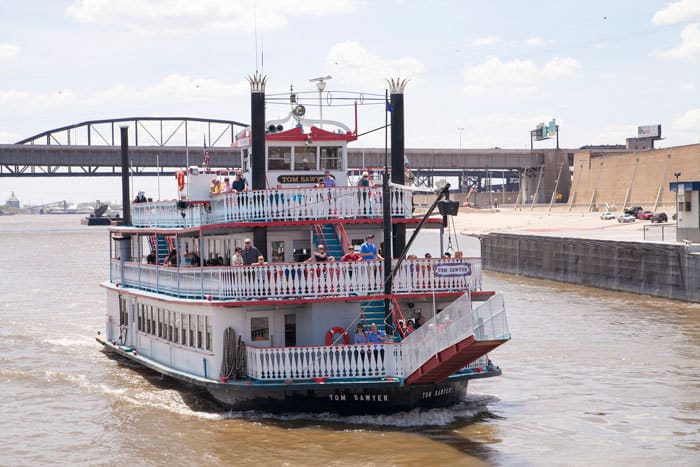
Before interstate highways crisscrossed the nation, people did their luxury traveling by train and steamboat. St. Louis was a bustling river town in the 1800’s with hundreds of steam powered paddlewheelers docked on riverfront! There’s a cool display of what St. Louis looked like back then at the Arch’s new museum –be sure to check it out on your next visit.
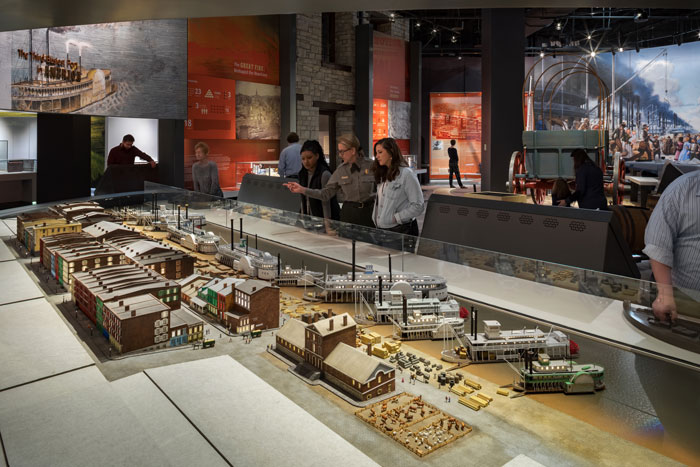
Riverboat Cruise at the Arch
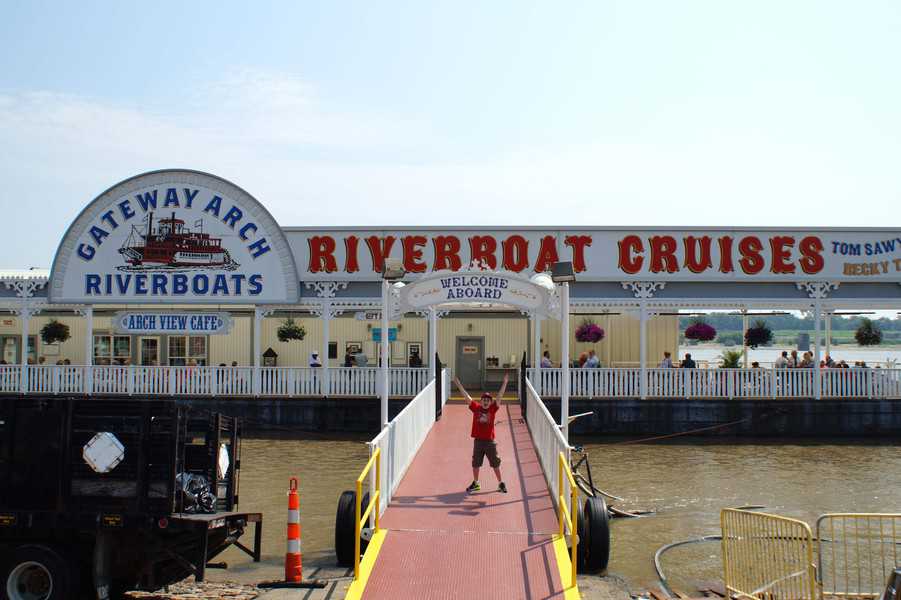
The riverboats can take your family on a hour long tour of the riverfront –there’s a sightseeing cruise running every day from March to November.
But if you want to make it really special–book a dinner or brunch cruise! The Becky Thatcher is set up with a double decker dining room and takes visitors on a two-hour tour of the riverfront while you dine on a delicious buffet.
Brunch on the Riverboat Becky Thatcher
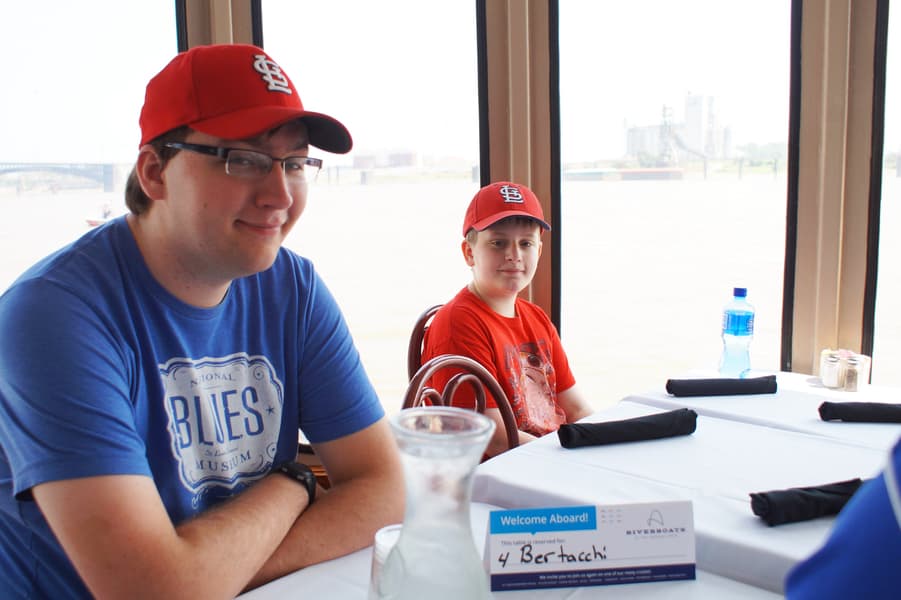
Sunday Brunch Cruises are a great way to celebrate Easter, Mother’s Day and Father’s Day. Of course you don’t need a special occasion to enjoy a wonderful weekend at the Arch with your family! There’s one or two brunch cruises scheduled every month the boats operates. Check out their current schedule under “specialty cruises” here. There’s also dinner cruises, dancing cruises, and a couple cruises up to see the lock and dam where the Missouri and Mississippi Rivers meet!
What’s included with my ticket?
Your brunch ticket includes a buffet full of scrambled eggs, blintzes, French toast, sausage, prime rib, stuffed chicken, veggies, pasta, dessert, and coffee, iced tea, orange juice, milk and chocolate milk. Soft drinks, beer and cocktails are available at the bar for an extra charge.

What to Expect on your Riverboat Brunch Cruise
First, you’ll want to reserve your spot early by getting tickets online . Tickets are $45 for adults, $18 for kids 3-12 and free for little ones under 2.
The boats are docked at the foot of the Gateway Arch. Stop by the ticket office to pick up your tickets by 12:30 — the boat leaves promptly at 1pm!
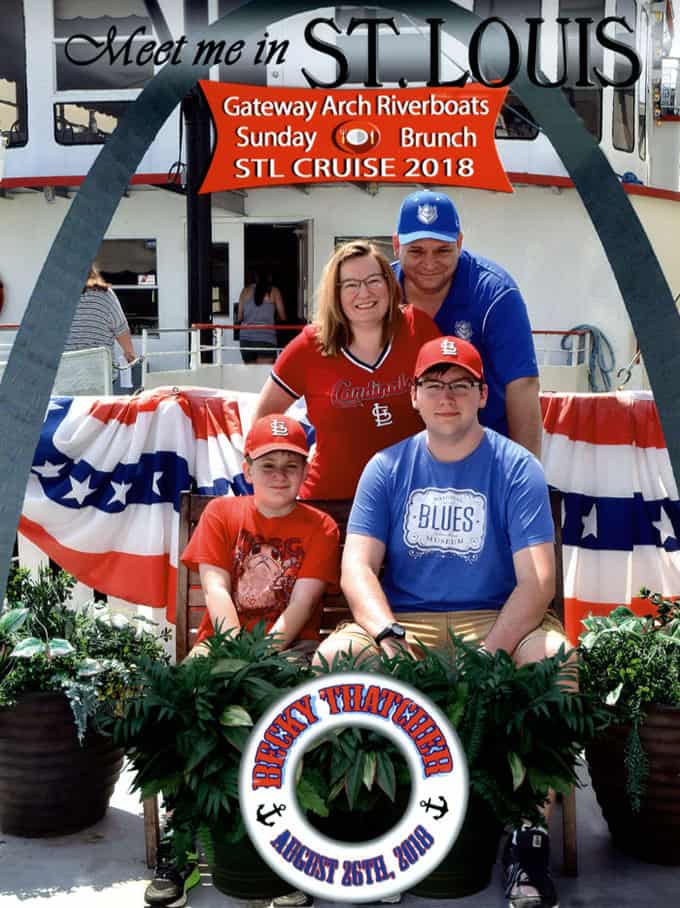
Then you’ll come aboard and be directed to your seat. Unlike the sightseeing tours, the Brunch Cruise has reserved indoor seating with white linen table clothes. Tables are located by the windows, so you can enjoy the whole cruise from the comfort of the cabin, or pop upstairs to watch from the observation deck.
The food might be served buffet style, but you’ll also get a friendly waiter to serve your drinks and clear the plates. Don’t worry about standing in line either, the serving staff dismisses diners by table so the buffet isn’t overwhelmed.
And while you wait, enjoy a little Dixieland music!

Where do I park?
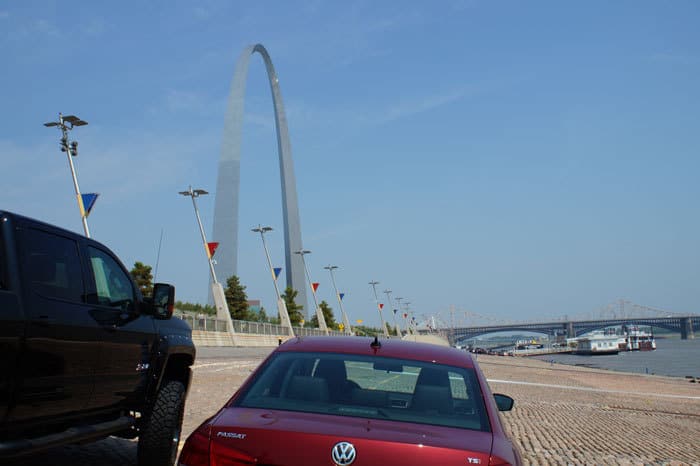
Best Photos of the Arch are Here
If you’re looking to get a postcard photo of the Gateway Arch, a riverboat cruise is where to be! You can also get a pretty cool one from the Malcolm W. Martin Memorial Park over on the East Side, but you don’t need to worry about pesky power lines messing up your shot here. ( Here’s a few more ideas for great photos with the Arch! )
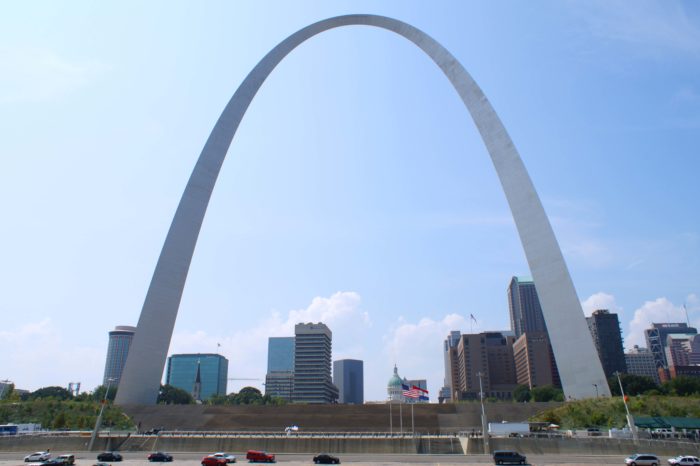
riverboat cruise parking
Find out where to park near Detroit Princess Riverboat and book a space. See parking lots and garages and compare prices on the Detroit Princess Riverboat parking map at ParkWhiz. ... Alexander Zonjic and Friends Dinner Cruise. Find parking. 29. Aug @ 6:00PM. Sunset Dinner Cruise. Find parking. 30. Aug @ 11:30AM. Lunch Cruise. Find parking. 30 ...
St. Louis Riverfront Cruise. Catch some of the best views of the Gateway Arch and downtown St. Louis on a fascinating one-hour riverboat tour. Daily cruises: 10:30 am, 12 pm, 1:30 pm, 3 pm, 4:30 pm, 6 pm, 7:30 pm (times vary day-to-day) Pricing: Adult: $24, Child (3-15): $14, Senior (60+): $22, Infant (0-2): FREE, * Group pricing available ...
Olsen Cruise Lines, cruise guests will park for free on some of the line's 2024 and 2025 voyages aboard the 1,400-guest Borealis. The limited-time offer is valid on bookings made through October ...
The Riverboats at the Gateway Arch are located on the Mississippi River, accessible from the cobblestone levee at 50 S. Leonor K Sullivan Blvd. (St. Louis, MO 63102). Riverfront parking is available for a fee (card only) and is not operated by the Gateway Arch or Riverboats at the Gateway Arch. To access the riverfront parking, take Chouteau ...
The Savannah River Cruise was an excellent way to get a perspective of Savannah from the water. Excellent narration full of interesting facts. Close passage of large ships underway highlighted the busy, commercial nature of the river today. Dolphin and Manatee sightings were a bonus. GetYourGuide traveler - United States September 20, 2022 ...
Boarding for the dinner cruise begins at 4:45pm, seating is first come first serve. All guests should arrive no later than 5:30pm to allow time for parking and boarding. The ships leave on time, so please be sure to allow enough time for traffic, parking, ticketing and boarding. You should arrive at approximately 4:45 for parking and boarding.
The Official Website of Savannah Riverboat Cruises. 912-232-6404. 9 E. River Street, Savannah, GA 31401 U.S.A. Have an account? LOG IN. Cruises; Groups; Weddings; Packages; FAQs; About; ... Tour the two Queens of the Savannah River! Hop aboard the Savannah River Queen or Georgia Queen to virtually navigate through each vessel's stunning ...
The Riverboats at the Gateway Arch are located on the riverfront's cobblestone levee at 50 S. Leonor K Sullivan Blvd., St. Louis, MO. To access the riverfront levee parking, take Chouteau Ave. to Leonor K Sullivan Blvd. Note: Riverfront levee parking availability is subject to weather and river conditions.
Please contact our ticket office 800-786-6404 with ANY questions. Where will we go on our cruise? It all depends on the length of your cruise. A typical lunch or dinner cruise will go up river towards the ports passing the Talmadge Bridge and then back around down river passing the waving girl until Fort Jackson.
Riverboat Cruises. About Us; Our Cruises; Event Cruises; Private Parties; Group Tours; Directions & Map; ... Follow the Barefoot Queen parking lot sign to your left. There will be a looping shuttle that will pick you up and drop you off at the ticket booth by the dock. ... If you need handicap accessible seating please notify us in advance ...
She lives in White River Junction, Vermont. She has previously worked for Fast Company, the Guardian, News Deeply, Time, and others. Message Michelle on Twitter or at [email protected] . Check ...
90-Minute Savannah Riverboat Sightseeing Cruise Questions & Answers. Where do we park? Is parking free? It's not free but you can park right near the boat - there are a few lots on E River St - 146 E River Street is right near the boat docks. There are parking ramps within about 4 blocks.
However, that comes at a cost. Cruise parking at the port is a flat fee of $25 per day with the total cost depending on the length of the cruise. Cash, credit, and debit cards are taken for payment. 4-day parking | $100. 5-day parking | $125. 6-day parking | $150.
CGA's parking situation is also so much better than Six Flags. Food prices are exorbitant and options are limited. $90 for 6 pretzels and 5 drinks. $80 for 2 hot dogs and 5 icees. $12 for popcorn. You can bring your own water bottle and refill at the park. Restrooms aren't the cleanest but they get the job done.
All of our cruises leave from Newport Landing Dock, which is located at 101 Riverboat Row, at the foot of Columbia St. adjacent to Newport Aquarium. ... Turn left onto Riverboat Row; Parking is available along Riverboat Row, and the dock is to the right; To confirm specific directions call toll free at 800.261.8586. Cruises; Dining Cruises;
Port of Galveston: Why You Should Drive to a Cruise in Galveston, TX. Located on an island and bay of the same name, the Port of Galveston is Texas' primary cruise gateway. Galveston is located ...
Absolutely Elvis! Presented by Todd Anderson. Friday, June 14, 2024 & September 6, 2024. Join us aboard our authentic paddle wheel boat for a live musical performance! Includes live music, excursion, cash bar, soft drinks, lemonade, and light snacks. Book Now.
As a replica of a 19th-century steamboat, the Michigan Princess has graced the Grand River for over 30 years, becoming an iconic Lansing tourist attraction. Nestled in the heart of mid-Michigan, our riverboat offers views of the Grand River, creating an intimate atmosphere with picturesque scenery. From weddings to proms, corporate events to ...
Our vessels and original docking facility are not required to be ADA compliant due to their age and historical standing. However, we routinely assist handicapped guests on to our vessels. Keep in mind while booking that our most handicap accessible boat is the Island Queen. Please call us at 901-527-2628 for specific information on this matter.
River Cruises reserves the right to cancel any cruise, change schedules or routes, and substitute vessels without prior notice. Cruises may be abbreviated, altered, or cancelled, if, in the judgement of the Captain, conditions are not conducive to safe operations. ... Parking. Free, ample, overnight parking is available at our boat dock in ...
For reservations, directions, or information please call or email CJC Cruises and the Detroit Princess Riverboat at: Phone: (313) 631-2628 or (877) 338-2628. Email: [email protected] .
BB Riverboats is the Official Riverboat Cruise Line of Cincinnati since 1979, offering premier sightseeing, dining, and private event cruises on the scenic Ohio River. Experience Cincinnati like never before aboard one our many themed event and dining cruises - one of Cincinnati's top things to do!'
This Mississippi River Cruise departs from Center Street Landing three times daily between Memorial Day and Labor Day, with two departures daily during September and October. Dinner cruises depart at 6:30 p.m; check for availability. Built in 1964, the Mark Twain Riverboat is 120 ft. long, 33 ft. wide and has a 400-passenger capacity, so there ...
Better Than Best Price Guarantee. Book 2025 & 2026 sailings at the lowest fares. Double the Cruise Credits. Double the Love. Receive 2x Cruise Credits with the purchase of the Plus/Premier Package prior to sailing. Let Princess take you on a cruise vacation to the Caribbean, Alaska, Europe & many more destinations.
The estuary´s vast waters are fed by an underground river, known as Rio San Jose, which inherits its water flow from the Sierra Laguna Mountains, located and visible within the near distance. For a very good part of nearly 300 hundred years, this now famous body of water has been the drinking and irrigation backbone of San Jose del Cabo.

How to Install Nginx, PHP, MariaDB, and PhpMyAdmin on Arch Linux
Due to its Rolling Release model which embraces cutting-edge software Arch Linux was not designed and developed to run as a server to provide reliable network services because it requires extra time for maintenance, constant upgrades, and sensible file configurations.
But, still, because Arch Linux comes with a core installation with minimal software pre-installed, it can represent a solid base start-up point to install most of the popular network services these days, including LEMP or LAMP , Apache Web Server, Nginx, PHP, SQL databases, Samba, FTP servers, BIND and others, many of them being provided from Arch Linux official repositories and others from AUR .
This tutorial will guide installing and configuring the LEMP stack ( Nginx , PHP , MySQL with MariaDB engine and PhpMyAdmin ) remotely using SSH , which can provide a strong foundation to build Web Server Applications .
Step 1: Assign a Static IP Address to Arch Linux Network Interface
1. After minimal Arch Linux core installation reboot your server, log in with the root account or equivalent administrative sudo account, and identify your system NIC device names using ip link command.

2. To assign static network configurations we are going to use the netctl package to manage network connections. After you have successfully identified your Network Interfaces names copy the ethernet-static file template to the netctl system path and change its name to a descriptive naming scheme ( try to use the “ static ” string combined with NIC’s name), by issuing the following command.
3. The next step is to edit this new template file by changing the file’s directives and providing your actual network settings (Interface, IP/Netmask, Gateway, Broadcast, DNS) like in the below excerpt.

Modify the file with your network settings:
4. The next step is to start your network connection through the netctl system tool and verify your system connectivity by issuing the following commands.
5. If you get an active green exit status you have successfully configured your Network Interface and it’s time to automatically enable it on system-wide services.
Also test your network by running a ping command against a domain name and also, install the net-tools package (the most well-known feature of this package is ifconfig command which Arch developers considered to be kind of deprecated and replaced with iproute2 ).
6. Now you can run the ifconfig command to verify your Network Interfaces settings and check if everything is correctly displayed, then reboot your system to make sure everything is in place and properly configured.

Step 2: Install LEMP Software on Arch Linux
As pointed out in this article’s introduction LEMP stands for Linux , Nginx , PHP / PhpMyAdmin, and MySQL / MariaDB which is one of the most widely spread web application platforms today after LAMP (the same stack with Apache in equation).
7. Before installing the LEMP stack we need to update the system and then gain remote control to the Arch Linux server. As you probably know OpenSSH is the main candidate for this job so go ahead and install it, start SSH daemon, and enable it system-wide.
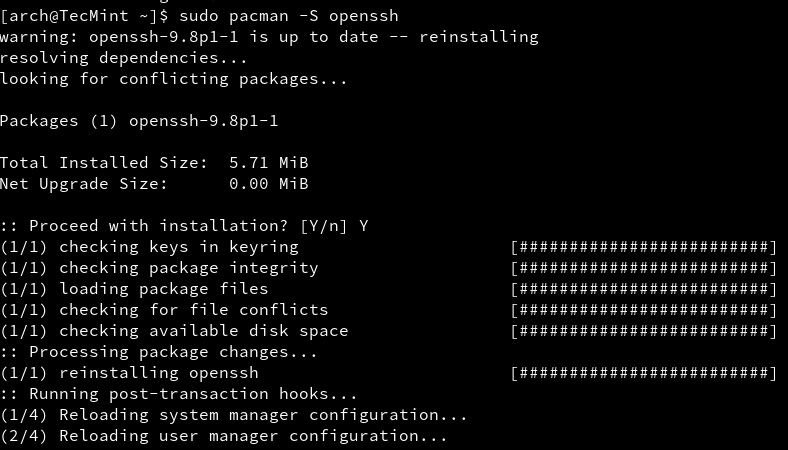
Now is the time to proceed with LEMP installation. Because this tutorial is meant to be a comprehensive guide I will divide LEMP stack installation into small pieces, step by step.
8. First install the Nginx Web Server , then start it and verify its status by issuing the following commands.

9. The next service to be installed is the MySQL database. Issue the following command to install the MySQL database server and choose the MariaDB engine, then start and verify the daemon status.
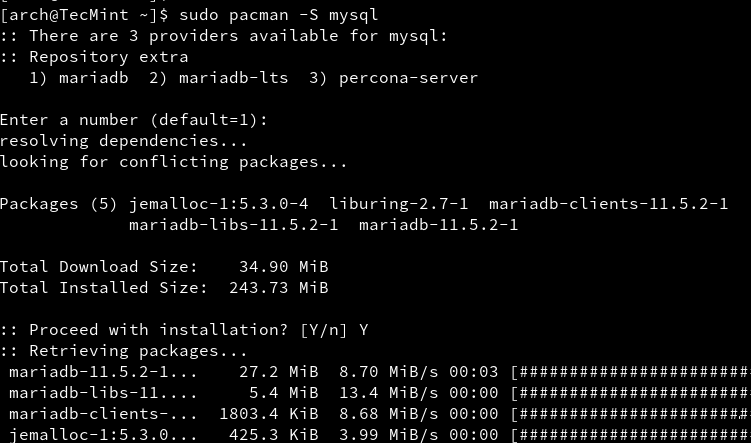
10. The next step is to provide a highly safe environment for MySQL databases by providing a password for the MySQL root account, removing an anonymous user account, remove the test database and root accounts that are accessible from outside localhost.
Run the following command to improve MySQL security, press [ Enter ] for the current root account password, then answer Yes to all questions ( also set up your root account password).
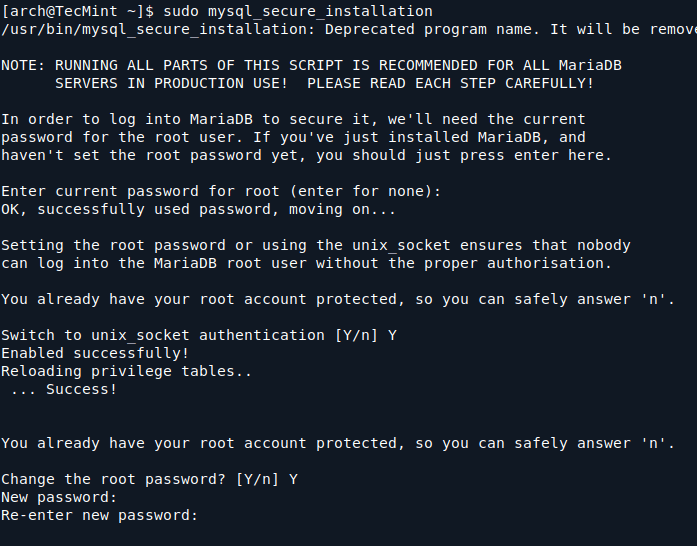
Note : By any means do not confuse MySQL root account with Linux system root account – they are two different things – not so different but they run on different levels.
To verify MySQL security login into the database using mysql -u root -p command syntax, provide your root password then leave the database with exit; command.
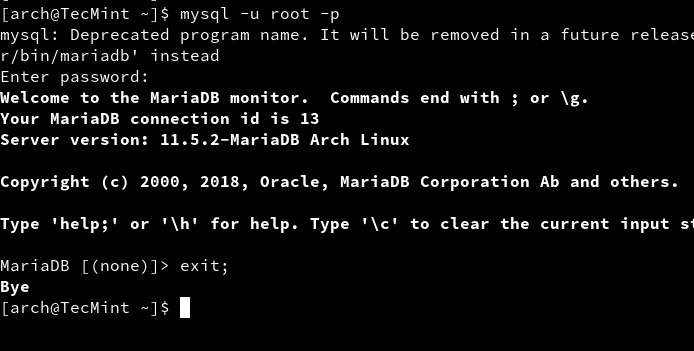
11. Now it’s time to install PHP server-side scripting language to be able to develop and run complex dynamic web applications, not just serve HTML/CSS code.
Because we are using Nginx as a web server we need to install a PHP-FPM- backed module to communicate through Fast Common Gateway and change dynamic content generated by PHP scripts.
Issue the following command line to install the PHP-FPM service, then start the daemon and verify the status.
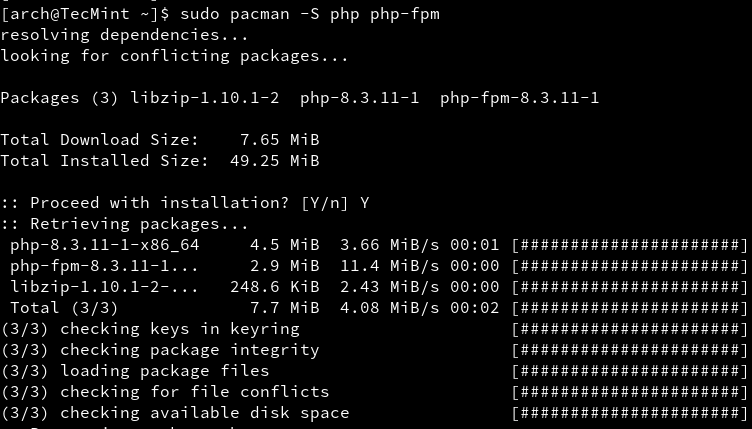
To list all available PHP module issues the following commands.
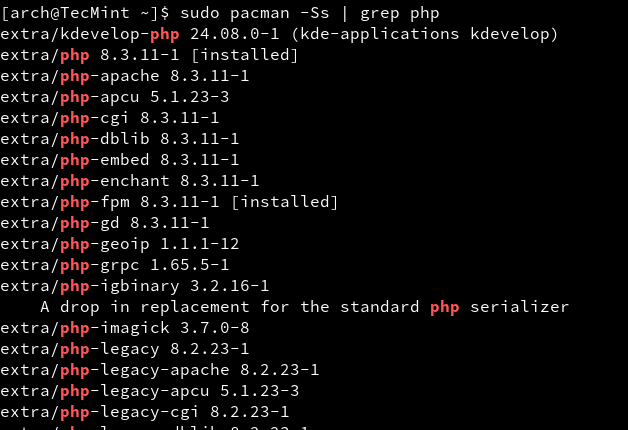
12. One of the last steps is to install the PhpMyAdmin Web Interface for the MySQL database. Issue the following command to install PhpMyAdmin along with its PHP-needed module then create a symbolic link for the PhpMyaAdmin system path to the Nginx default root path.
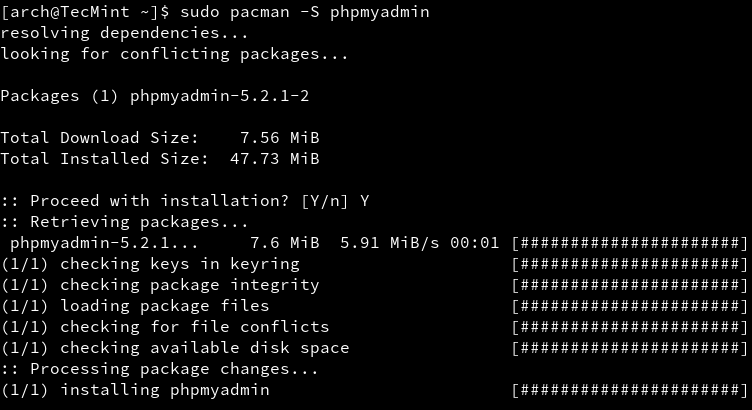
13. Then configure the php.ini file to include the necessary extensions needed by the PhpMyAdmin application.
Locate with [ CTRL+W ] keys and uncomment (remove ; at the line beginning) the following lines.
On the same file locate and edit open_basedir directive to resemble the following included directories.
14. The next step is to enable PHP-FPM FastCGI on the localhost Nginx directive. Issue the next command to backup nginx.conf web server file configuration then replace it with the following content.
Add the whole following content on nginx.conf .
15. After all file configurations have been made, all you need to do is to restart Nginx and PHP-FPM services and point your browser to http://localhost/phpmyadmin URL from local node or http://arch_IP/phpmyadmin form another computer.

16. If everything runs as intended the final step is to enable LEMP system-wide with the following commands.
Congratulations! You have installed and configured LEMP on Arch Linux and, now, you have a full dynamic interface to begin and develop web applications.
Although Arch Linux is not the most very-best suited system to run on production servers due to its community-orientated rolling release model it can be a very fast and reliable source for small non-critical production environments.
Hey TecMint readers ,
Exciting news! Every month, our top blog commenters will have the chance to win fantastic rewards, like free Linux eBooks such as RHCE , RHCSA , LFCS , Learn Linux , and Awk , each worth $20 !
Learn more about the contest and stand a chance to win by sharing your thoughts below !

Previous article:
Each tutorial at TecMint is created by a team of experienced Linux system administrators so that it meets our high-quality standards.
Related Posts

How to Install Cinnamon Desktop and Basic Software in Arch Linux

How to Install XFCE Desktop on a Fresh Arch Linux System

A Beginner’s Guide to Installing Arch Linux on UEFI Machines

How to Install Yay AUR Helper in Arch Linux and Manjaro

10 Best Arch Linux Based User Friendly Distributions

How to Reset Forgotten Root Password in Arch Linux
Thanks a lot man! But what’s the main different between apache server and nginx server?
Nginx is faster than the Apache web server for handling high traffic..
This is a whopping tutorial. I love it!! But one problem mcrypt is now an AUR package. Even worse, it doesn’t quite work. MyPhpAdmin is broken somehow. Probably because it needs that package to work. I don’t know specifically what to do. Otherwise this tutorial is brilliant!
hi , Thank u for the awesome tutorial.
I wud like to suggest a small change: mysql.so is deprecated now so can u change it to pdo_mysql.so
Thanks for this excellent guide!
Got Something to Say? Join the Discussion... Cancel reply
Thank you for taking the time to share your thoughts with us. We appreciate your decision to leave a comment and value your contribution to the discussion. It's important to note that we moderate all comments in accordance with our comment policy to ensure a respectful and constructive conversation.
Rest assured that your email address will remain private and will not be published or shared with anyone. We prioritize the privacy and security of our users.
Save my name, email, and website in this browser for the next time I comment.
- Today's news
- Reviews and deals
- Climate change
- 2024 election
- Newsletters
- Fall allergies
- Health news
- Mental health
- Sexual health
- Family health
- So mini ways
- Unapologetically
- Buying guides
- Labor Day sales
Entertainment
- How to Watch
- My watchlist
- Stock market
- Biden economy
- Personal finance
- Stocks: most active
- Stocks: gainers
- Stocks: losers
- Trending tickers
- World indices
- US Treasury bonds
- Top mutual funds
- Highest open interest
- Highest implied volatility
- Currency converter
- Basic materials
- Communication services
- Consumer cyclical
- Consumer defensive
- Financial services
- Industrials
- Real estate
- Mutual funds
- Credit cards
- Balance transfer cards
- Cash back cards
- Rewards cards
- Travel cards
- Online checking
- High-yield savings
- Money market
- Home equity loan
- Personal loans
- Student loans
- Options pit
- Fantasy football
- Pro Pick 'Em
- College Pick 'Em
- Fantasy baseball
- Fantasy hockey
- Fantasy basketball
- Download the app
- Daily fantasy
- Scores and schedules
- GameChannel
- World Baseball Classic
- Premier League
- CONCACAF League
- Champions League
- Motorsports
- Horse racing
New on Yahoo
- Privacy Dashboard
Birds migrating over Missouri by the millions, Gateway Arch turns dark
Millions upon millions of birds will be on the move overnight, as the southern fall migration is in process. In honor of the annual pilgrimage, the Gateway Arch will go dark for the month of September, during the peak of the fall migration.
Recommended Stories
10 must-have nordstrom new arrivals to shop in september — starting at $24.
I'm a shopping editor and I can't stop thinking about this month's finds from major brands like Hoka, Spanx, Le Creuset and Vince Camuto.
I'm a fashion expert — here are the must-have fall finds I'm buying from Amazon
From trending loafers to a sleek turtleneck that's meant to be layered — give your closet an awesome autumn upgrade for as little as $12.
Patio furniture covers are up to 50% off at Amazon for a limited time
Winter is coming! Cover those sofas, chairs, ottomans, grills and more to preserve your outdoor pieces until next year.
Paylocity acquiring corporate spend startup Airbase for $325M
HR and payroll software company Paylocity has agreed to acquire corporate spend startup Airbase for $325 million, the companies announced Wednesday. The deal is subject to regulatory approval and is expected to close in the first or second quarter of Paylocity’s fiscal year, which would be sometime in the next 30 to 60 days. It’s a decent exit for seven-year-old Airbase, which was founded by Thejo Kote in 2017 to provide software to mid-sized companies seeking to better manage their spending.
Beyond Meat CEO: The company continues to innovate its products amid leaner times
Beyond Meat founder and CEO Ethan Brown stays firm in his outlook for the company and industry.
Ryan Breslow's $450M Bolt deal said to involve a restraining order now
Ryan Breslow’s plan to get himself reinstalled as CEO of fintech company Bolt — and push through a $450 million fundraising deal that would value the startup at a staggering $14 billion — has apparently stalled. According to Forbes, Breslow sent an email to shareholders thanking them for signing off on the deal. The problem is that many of those investors, including Montauk Ventures and Ash Pournouri, claim they didn’t sign off on anything.
It List guide to reality competition shows: The most bizarre and heartfelt series of the fall season
Here are the biggest reality competition shows on TV this fall, from "Dancing With the Stars" to "The Golden Bachelorette."
X is hiring staff for security and safety after two years of layoffs
Nearly two years after the layoffs across X’s trust, safety and security teams, Elon Musk’s social media company is now trying to hire new employees to help moderate content and secure its platform, according to X’s official job listings. In the last month, X posted two dozen job openings evenly split across its safety and cybersecurity teams. In April 2023, Musk told the BBC that Twitter, as it was known then, reduced its headcount by 6,000 workers in six months, leaving the company’s workforce at around 1,500 employees when layoffs were completed.
Intel’s next-gen chip manufacturing process reportedly hits snag after failing crucial tests
Intel’s next-gen chip manufacturing process hits snag after reportedly failing crucial tests. Broadcom found that the technique isn’t quite ready for high-volume production.
Kitchen too dark? These no-install under-cabinet lights are down to $18 a pair
'Instantly enhanced the ambiance,' said a fan. Give your home a cozy glow via these motion-activated magnets.
Stylish neo-noir detective game Phoenix Springs is delayed until October 7
Gorgeous neo-noir detective game Phoenix Springs has been delayed until October 7.
Fall travel plans? This 'packing miracle' is now just $16 with Amazon Prime
These space-saving nylon cubes will turn you into a tidier traveler.
As remote working keeps rolling, Oyster raises $59M Series D at $1.2B valuation
No one is putting the remote working genie back in the bottle. Which is good news for Oyster, a payroll and HR platform that specializes in distributed workforces — or “global employment” as its marketing paints it. The 2019-founded U.S. startup has just closed a $59 million Series D funding round led by Silver Lake Waterman.
Bitcoin ATM scams have cost Americans over $10 million per month this year
The Federal Trade Commission has published a report that aims to warn people about Bitcoin ATM (or BTM) scams, which have apparently increased tenfold from 2020 to 2023.
A Minecraft Movie trailer gives us our first look at Jason Momoa and Jack Black ahead of its 2025 release
It's finally coming to theaters.
Linda Sun, former aide to Gov. Hochul, charged with spying for Chinese government. What we know so far.
Linda Sun, who worked in high-ranking roles in Gov. Kathy Hochul and former Gov. Andrew Cuomo's administrations, was arrested with her husband Tuesday morning.
Dutch clean energy investor SET Ventures lands new €200 million fund, which will go toward digital tech
New climate tech VC firms have emerged in recent years, but existing ones are also raising larger funds. Founded in 2007, Dutch firm SET Ventures is one of the latter. Its fourth fund, which just closed at €200 million, is twice the size of its previous one, and will be deployed into 20 to 25 European startups making renewable energy more mainstream.
Microsoft brings 5G to its latest Surface Pros for Business
Today, the company announced that 5G versions of the Surface Pro 10 and Surface Pro (Copilot+) for Business will be available on September 26.
With $50M in new funding, You.com thinks its AI can beat Google on hard questions
If you build an AI search product, you compete with Google. Emboldened by a new $50 million funding round, the consistently innovative yet often overlooked AI company aims to excel where other AI companies raising billions falter. It would be futile to compete on the simple questions that make up the vast bulk of Google searches -- basic facts, conversions and references.
How Apple Intelligence is changing the way you use Siri on your iPhone
Following years of talk around Apple’s lack of innovation when it comes to Siri, Apple has promised the launch of a smarter version of its digital assistant coming this fall. Siri is getting a slew of new features and updates thanks to the addition of Apple Intelligence, the company’s generative AI offering, and a partnership with OpenAI. From ChatGPT integration to the ability to type instead of speak to Siri, there's a lot of ways Siri will change in the coming months.
essay on thriller genre
Academia.edu no longer supports Internet Explorer.
To browse Academia.edu and the wider internet faster and more securely, please take a few seconds to upgrade your browser .
Enter the email address you signed up with and we'll email you a reset link.
- We're Hiring!
- Help Center

The Psychological Thriller: An Overview

2014, Critical Insights: The American Thriller
My chapter in Salem Press's recent entry to its Critical Insights series, _The American Thriller_ (2014). As the title indicates, it is a history of the development of the psychological thriller in American culture.
Related Papers
A Companion to Crime Fiction
Philip L Simpson
Horror Studies
Steven Bruhm
Paul Cobley
The following essay considers some of the consequences of Sebeok and Eco’s The Sign of Three (1983) for the broad history of the thriller, for the theory of genre, and in terms of an investigation of the relations between genre and subjectivity. It is not a fully worked-out history of the thriller and fictional detection in light of the scholarship concerned with abduction. Rather, it is a mere sketch of how such a history might look. It attempts to cast some light on the process of generic canon-building. It also poses a relation between the growth of ‘social paranoia’ in the history and cultural growth of the thriller and the general phenomenon of ‘anxiety’ which is pivotal to the biosemiotic foundations of what has been called by Sebeok (1979) and others (e.g. Wiley 1994) the ‘semiotic self’.
Pablo Echart , Pablo Castrillo Maortua
The Hollywood political thriller is a film genre of unique relevance in the United States, often acting as a reflection of the fears and anxieties of its historical times. At the same time, however, the definition of its identity and boundaries still leaves room for further specification, perhaps due to the frequent consideration of the political thriller as part of the broader categories of either thriller narratives or political films. By revising the available literature and filmography and analyzing the narrative features of the classical political thriller, this article proposes a deeper definition of the genre that takes into account the nature of the broader ‘thriller’ category of films springing from a specific mode of crime fiction that focuses on a victim or threatened individual as its protagonist, depicts and conveys intense emotional states, portrays an unbalanced and highly existentialist worldview, and travels into the extraordinary while at the same time holding on to very concrete expectations of verisimilitude. The political thriller specifies this broader form of narration and links it to dramatic conflicts of political nature, investigative plots, reactive characters, historically grounded antagonists, a proximity to the sociopolitical history of the United States, and a certain iconography relating to institutional power. By establishing the main narrative traits of the political thriller, this definition hopes to lay the foundations for a better understanding of the genre, its history, and its seeming renaissance at the onset of the 21st Century.
Bowdoin Journal of Cinema
Bowdoin Journal of Cinema , Christine Rosa
American Psycho (2000) is based on Bret Easton Ellis’s controversial 1991 novel of the same name, and details the exploits of investment banker/serial killer Patrick Bateman (Christian Bale). Upon its release, notable feminists such as Gloria Steinem opposed the depicted violence towards women, and the graphic content was so disturbing that several countries established restrictions for acquiring the book. Despite the heated response to Ellis’s work, a modestly successful film version was released within the decade. This paper investigates the factors contributing to the success of the film and its enduring popularity with viewers and scholars alike, despite tackling such provocative material. Undoubtedly, female director and co-screenwriter Mary Harron deserves much of the credit for bringing the story to life with a tasteful sensibility that is crucial to the film’s transcendence beyond a mere slasher film, an aspect which distinguishes the film from its contemporaries. Her use of the ‘female gaze’ in portraying the hypermasculine world of protagonist Patrick Bateman lends the material a restrained quality and subverts the established paradigm of power in gender dynamics. Bateman, the epitome of white male privilege who navigates his world looking to dominate people he comes across, is steadily dismantled and stripped of his façade until he registers as more pitiable than frightening. The film places society under the microscope as much as the deplorable murderer at the center of its storyline, revealing the abhorrent reality of a world in which the appearance of success is more important than the conveyance of something real. In this depiction of New York City during the late 1980s, consumerism, superficiality, and societal expectations reign supreme, and Harron displays this worship of artificiality in shot after shot illuminating the lifestyle of the uber-rich. This critique of American culture endures into modern- day, and the palpable truth surrounding our collective warped sense of prioritization ensures its relevance. Like all good satires, American Psycho has valuable lessons to impart. It goes beyond condemnation of the shortcomings of society through dark comedy, however, to a genuinely thoughtful exploration of a human mind cultivated within an ethos of insincerity. What the viewers are left with is a deeply personal character study which forces them to empathize with a murderous psychopath trapped within a state of alienation and anonymity and desperate for something real. Similar to recent box office triumph Joker (2019), mental illness permeates the narrative, and although Bateman’s outbursts are extreme and exploited for comedic effect, viewers are ultimately meant to identify with the struggles which cause them. At the heart of his character exists an insecure human being who grapples with the sobering fact that no matter what he does, his life is entirely ineffectual.
New Review of Film and Television Studies
frank krutnik
Nick Redfern
The mental flow model of the viewer’s experience of the cinema takes film genres to be forms constructed in order to evoke characteristic emotions that are intimately connected to generic themes and narrative structures. In this model, the horror film evokes the emotion ‘fear,’ producing autonomic responses of crying, shivering, and screaming in the viewer. Paranoia is frequently cited as a recurrent generic theme of the horror film, and, in some case, critics have identified a sub-genre of ‘paranoid horror’ films. However, the characteristic emotion of paranoia is not fear but ‘anxiety,’ and films that evoke such a state in the viewer demonstrate numerous differences from the horror genre. These differences are evident in the type of emotional responses experienced by the viewer and the level of their intensity, as well as in the generic themes and narrative structure of these films. Examples of these differences can be found in Hollywood-produced films such as The X-Files (1998) and Enemy of the State (1998). In light of these differences, the paranoid film can be regarded as a category distinct from the horror film.
Angelaki-journal of The Theoretical Humanities
Cecil Greek
The most gripping and recurrent visualizations of the “monstrous ” in the media and film lay bare the tensions that underlie the contemporary construction of the “monstrous, ” which ranges in the twilit realm where divisions separating fact, fiction, and myth are porous—a gothic mode. There appear to be two monstrous figures in contemporary popular culture whose constructions blur into each other, and who most powerfully evoke not only our deepest fears and taboos, but also our most repressed fantasies and desires: the serial killer and the vampire. The social construction of these figures, in feature films that invoke the genre traditions of the documentary, melodrama, horror-psychological thriller, and romance form a significant section of this article; it is the easy slippage between cinema-verité depictions and horror-psychological thriller narrative modes that renders the gothicization of the serial killer as vampire compelling. This social construction will not only cover the ...
Journal of Religion and Health
Donald R Ferrell
Loading Preview
Sorry, preview is currently unavailable. You can download the paper by clicking the button above.
RELATED PAPERS
Gregory Desilet
Mark Jancovich
Atlantis Journal
Virginia Luzon-Aguado
Yo'Av Dar
Quarterly Review of Film & Video
The Journal of Psychiatry & Law
Philip Witt
Film & History, 52.1
Khara D Lukancic
Luciano Cabral
Christina Meyer
Rainbow: Journal of Literature, Linguistics and Cultural Studies
rohaeni nurhasanah rohaeni
Sonia Baelo-Allué
Dr. Anindya Sundar Polley
Aalya Ahmad
Catherine Bruzdzinski
Ronald Schouten
Agnieszka Soltysik
European Journal of American Culture
Jurnal Kibas Cenderawasih
Sulistya Ningtyas
International Criminal Justice Review
Contemporary Psychoanalysis
sheldon itzkowitz
Ezikov Svyat volume 18 issue 3
Boyka Ilieva
Kristi Pierse
MA dissertation
Nur Ozgenalp
Peter Knight
RELATED TOPICS
- We're Hiring!
- Help Center
- Find new research papers in:
- Health Sciences
- Earth Sciences
- Cognitive Science
- Mathematics
- Computer Science
- Academia ©2024
VIDEO COURSE
Finish your draft in our 3-month master class. Sign up now to watch a free lesson!
Learn How to Write a Novel
Finish your draft in our 3-month master class. Enroll now for daily lessons, weekly critique, and live events. Your first lesson is free!

Blog • Perfecting your Craft
Posted on Oct 01, 2018
How to Write a Thriller in 7 Heart-Stopping Steps
About the author.
Reedsy's editorial team is a diverse group of industry experts devoted to helping authors write and publish beautiful books.
Someone has been kidnapped and your protagonist is trying to prevent their murder. The clock is ticking but their car has just exploded, the building they were in has been set on fire, and, as they turn around to try to escape, they are face-to-face with a gun…. Now what ? Since you’re here, you obviously want to answer that question by writing your own thriller.
In this post, we look at how to write a thriller by outlining the main characteristics of the genre and turning to professional editors for their top tips.
What is a thriller?
A thriller is a fast-paced novel full of conflict , tension, suspenseful action , unexpected twists, and high stakes. Every single scene and element in a thriller is meant to propel the action forward, test the characters, and take the readers on a roller coaster ride that will leave them on the edge of their seats.
What is the difference between thrillers, mysteries, and suspense fiction?
Readers often conflate thrillers with mystery or suspense novels, which is perfectly understandable — bookstores often shelve them in the same section. But what are the differences between these other genres (if there are any)?
When it comes to the differences between thrillers and suspense novels, editor Allister Thompson suggests there is not a huge difference. He says that “the element of surprise, the release of tension, may be more important in suspense (the tension has to break at some point), while it could be said that a thriller needs more visceral action.” In a thriller, the danger, twists, and surprises that await the protagonist are important for maintaining the pace of the novel and keeping the reader on their feet.
In thriller and mystery novels, the action is driven by separate forces. According to editor Anne Brewer: “In a mystery, the plot is driven forward by the protagonist, a sleuth, who is investigating a murder… In a thriller, the action is driven forward more generally by elements beyond the protagonist's control.” In both cases, the protagonists might be working toward solving a case, but the events that surround them — and how they get into them — are completely different. Another difference is that mystery novels generally involve a protagonist who is faced with a crime that they need to solve. On the other hand, in thrillers, the protagonist might need to stop the crime from happening in the first place.
Perhaps most crucially, the whole point of a mystery is to figure out the culprit. However, in thrillers you might discover the Big Bad on the very first page — which means they’ll be posing a threat to the protagonist from the start.
PRO-TIP: To read 22 of the best psychological thrillers, check out this post right here .
Thriller subgenres
Thrillers are just one term for a large category of fiction that includes various subgenres. Although it might seem trivial, deciding on a subgenre will actually help guide your writing since you’ll know where it fits in the market. They can encompass:
- Supernatural, like the Duffer brothers' Stranger Things
- Politics, like Michael Dobbs’ House of Cards
- Espionage, like Red Sparrow by Jason Matthews
- Psychological, like The Girl Who Loved Tom Gordon by Stephen King
- Action-adventure, like Breakthrough by Michael C. Grumley
- Crime , like What Have You Done by Matthew Farrell
- Historical, like Lies She Never Told Me by John Ellsworth
- Legal, like Juror #3 by James Patterson and Nancy Allen
- Military, like Tom Clancy’s The Hunt for Red October
- Domestic, like Harlan Coben’s The Stranger
There is often some overlap among the subgenres, so don’t be surprised to find a book in two — or even three — different categories. Whichever subgenre you settle on, we recommend reading books that fit into that category to get an idea of the common elements that are often present.
So, now that we have defined what a thriller is and its characteristics — let’s see how to write one.
Which genre (or subgenre) am I writing?
Find out which genre your book belongs to. It only takes a minute!
How to write a thriller in 7 steps
There’s no fool-proof way of writing a successful thriller (if there was, everyone would do it), but there are ways to ensure that your novel ticks all the right boxes. Based on advice from our network of editors, this is our take on how to write a thriller.

1. Flesh out your characters and their motivations
Characters in thrillers are usually complex. The good guy might not be the model citizen, and the bad guy may have a justification and conviction for everything they do — at least in their mind.
The rivalries between these opposing forces is what will give rise to the action that will propel your story forward, so you need to give each of your characters a clear goal and motivation . Ask yourself:
- Why do they what they do?
- What is their ultimate goal?
- Does the protagonist need to save him or herself or somebody else?
- How do they react in the face of adversity?
One great exercise when carrying out this kind of character development is to fill out a character profile template. You can try out our free one below. Lucky you!

FREE RESOURCE
Reedsy’s Character Profile Template
A story is only as strong as its characters. Fill this out to develop yours.
2. Start with action
The opening scene is a pivotal moment in any book. In thrillers, it’s especially important because you need to start with action from the get-go. Oftentimes starting in medias res is a good way to accomplish this. Avoid an “info dump” where you accidentally include too many irrelevant background details.
You don’t necessarily need to start with a murder — in fact, in some thrillers, there isn’t one at all or it doesn’t happen until half way through the novel — but you need to start with something exciting that sets the protagonist in motion.
In the very first chapter of The Bourne Identity by Robert Ludlum, someone on a boat falls into the waters of the Mediterranean after being shot — we don’t know who or why. He is eventually rescued by a fishing boat, and we find out that this survivor has amnesia. At this point, the reader has virtually no information about the characters or the plot of the book before being launched into a life-threatening situation.
3. Show what’s at stake
High stakes are characteristic of thrillers, but the particulars change depending on the subgenre. For example, in a domestic thriller, the stakes will be more character-specific. Contrast this to a military or political thriller, where the consequences will probably be broader, affecting the fates of a group, country, or even the world.
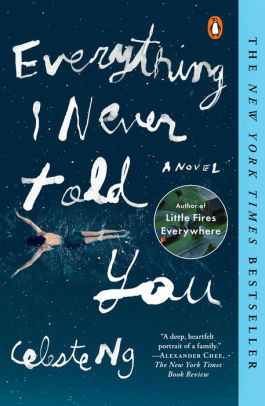
In Everything I Never Told You by Celeste Ng, a daughter’s disappearance and death puts the family at risk of completely shattering while they try to find out what happened to her. In this domestic thriller, the stakes are specific to the family. Even though they are the only ones affected by the events, it’s just as effective.
4. Make it difficult for your protagonist
Your audience needs to care for your protagonist and their fate, and a good way to do this is by placing them in situations where it’s impossible to tell if they’ll make it or not. This will help heighten the stakes and make their eventual success much more satisfying for the readers. So, put your characters in jeopardy by having dangerous situations come at them from unexpected places! Make their trusted allies turn on them seemingly out of the blue.
In Gillian Flynn’s Gone Girl (spoilers!) , protagonist Nick is the main suspect for the murder of his wife, Amy, who disappeared on their fifth wedding anniversary. Even though he is made to look like the culprit, we later find out that everything had been staged by Amy herself as a plan to accuse Nick of murder. While Amy coming “back to life” is meant to exonerate him and bring his life back to normal, it ends up being worse as he’s then forced to live under her threats.
5. Bring on the twists
As we have established, thrillers are mainly propelled by plot events, and the best way to keep readers engaged in the plot is by introducing twists and unexpected events . This is easier said than done, as twists can sometimes have the opposite effect. So, if you are not sure if your twist is enough to keep the story moving, Anne Brewer suggests asking yourself the following questions:
- Is my protagonist behaving as actively as possible, or sitting back and letting things happen?
- Is this twist as exciting as it could be?
- Does the twist feel “big” enough?
- What’s the worst thing that could happen to my protagonist right now?
Once you have the answer to these questions, make it happen .
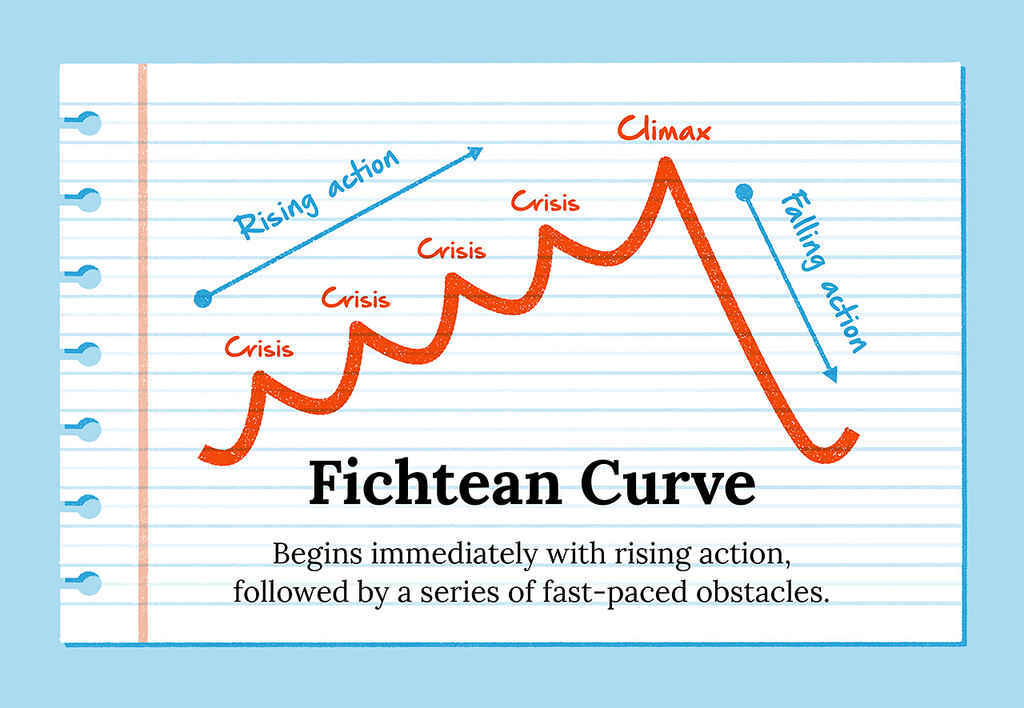
6. Build up to the climax
Now it’s the moment that the protagonist — and the readers — have been waiting for: the final showdown against the antagonist that will decide everything.
The climax is a pivotal scene in your book , so make sure you dedicate time to polishing it and make it really shine. In particular, it may be helpful to write the climax first so that you already know where your characters need to end up. Once you’ve established that, you can pave their way through your plot twists. If you'd like some inspiration, go here for a list of 70+ plot twists.
7. Give your story a satisfying ending
A satisfying ending isn’t necessarily a “happily ever after.” Keep in mind the kind of story you’ve been telling so far and make sure the ending fits well.
In some cases, you may want to completely tie all the threads and answer all the questions. Or you might want to leave it as an open ending, where the final conclusions are left to the reader’s interpretation. If your plan is to write a series of books, then a cliffhanger might be the way to keep readers on the hook. Whatever kind of conclusion you go for, remember that it’s always necessary to wrap up the current action so that there’s a sense of satisfaction at the end of the book.
Now that we’ve covered seven steps to write a thriller, let’s cover a few bonus tips to ensure that it leaves a lasting impression.
Bonus tips from professional editors
Writing a gripping thriller can be a challenge, so we turned to our top professional editors for tips to help you write your own page-turner.

Avoid anything that bogs down the pacing
According to editor Anne Brewer, “Thriller writers should avoid anything that bogs down their pacing. This tends to be either getting too wrapped up in everyday details or getting mired in plot developments that aren't exciting enough for the genre.” If you see that a scene or a plot doesn’t add enough excitement or it slows down the action instead of moving it along, take a step back and rewrite it.
Don’t mislead the reader
“If you are writing a thriller, or something you wish to call one, then action and/or danger must be there. If you write another kind of mystery novel that is gentler or more procedural and call it a thriller, you're misleading the reader,” says editor Allister Thompson. It is important that you stay true to the genre throughout the novel — otherwise you might just turn away readers instead of gaining them.
Don’t let your imagination get bogged down
When writing a book, it’s easy to let yourself be constrained by the limits set by your own abilities. However, Anne Brewer warns against this, saying: “Try not to let your imagination get restrained with what might normally happen: plot twists in thrillers are entertaining because they're inventively outside the norms.”
Make sure the stakes are high enough
“A thriller needs to have a palpable sense of tension or danger or, at worst, dire consequences that the characters are trying to avoid or escape. And there must be pitfalls along the way,” says Allister Thompson. In other words: make absolutely sure that the stakes are high for your protagonist, so that they are compelled to keep the story moving forward.
To write your own unstoppable thriller , don’t forget to create that action-driven tension, conflict, and suspense. Turn everything upside down — for the protagonist and the reader — with every turn and twist.
What are some of your favorite thrillers? Let us know in the comments below!
6 responses
Thomas Peterson says:
17/07/2019 – 14:02
It was great that you mentioned the climax is the most important scene to make great. I love reading and writing modern women suspense novels and it's great to get some tips on how to make the writing so much better and to help me understand these things when reading them. I would love to try some of these tips to enhance my reading and writing greatly.
↪️ Yvonne replied:
08/08/2019 – 01:54
Glad that you found the article useful and hope that you've gotten a chance to apply the tips! Looking forward to the success story :)
Kevon Brown says:
06/08/2019 – 12:54
Informative stuff!! Great job. Keep sharing.
Thanks for reading, Kevon!
Mary Hutson says:
15/01/2020 – 02:49
For anyone who would like to read a couple of very good Crime thrillers, checkout "Snapped" or "Sniper's Nest" by CM Sutter. I got them as free Kindle books on amazon .com and now, I'm learning how to write my own thriller. They brought me more joy than any other book I've read in years! The author's website: www.cmsutter also offers free downloads. I guarantee you'll be impressed.
Penelope Smith says:
11/03/2020 – 03:28
I liked your suggestion about not misleading the reader. It is always nice to know that you could have figured out the mystery in a book. I love reading books where I can try to start putting the pieces together early on and getting that pay off for that work later on.
Comments are currently closed.
Continue reading
Recommended posts from the Reedsy Blog

100+ Character Ideas (and How to Come Up With Your Own)
Character creation can be challenging. To help spark your creativity, here’s a list of 100+ character ideas, along with tips on how to come up with your own.

How to Introduce a Character: 8 Tips To Hook Readers In
Introducing characters is an art, and these eight tips and examples will help you master it.

450+ Powerful Adjectives to Describe a Person (With Examples)
Want a handy list to help you bring your characters to life? Discover words that describe physical attributes, dispositions, and emotions.

How to Plot a Novel Like a NYT Bestselling Author
Need to plot your novel? Follow these 7 steps from New York Times bestselling author Caroline Leavitt.

How to Write an Autobiography: The Story of Your Life
Want to write your autobiography but aren’t sure where to start? This step-by-step guide will take you from opening lines to publishing it for everyone to read.

What is the Climax of a Story? Examples & Tips
The climax is perhaps a story's most crucial moment, but many writers struggle to stick the landing. Let's see what makes for a great story climax.
Join a community of over 1 million authors
Reedsy is more than just a blog. Become a member today to discover how we can help you publish a beautiful book.
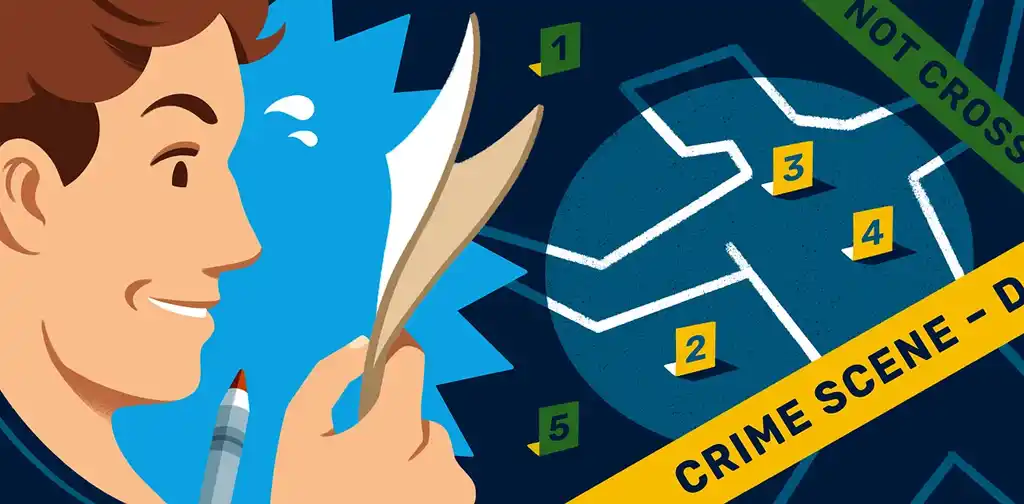
Meet crime editors
Sign up to request quotes from editors who shape bestsellers.

1 million authors trust the professionals on Reedsy. Come meet them.
Enter your email or get started with a social account:
Definition of Thriller
Elements of a thriller, common characters in thrillers, examples of thriller in literature.
I returned from the City about three o’clock on that May afternoon pretty well disgusted with life. I had been three months in the Old Country and was fed up with it. If anyone had told me a year ago that I would have been feeling like that I should have laughed at him; but there was the fact. The weather made me liverish, the talk of the ordinary Englishman made me sick, I couldn’t get enough exercise, and the amusements of London seemed as flat as sodawater that has been standing in the sun. ‘Richard Hannay,’ I kept telling myself, ‘you have got into the wrong ditch, my friend , and you had better climb out.’ It made me bite my lips to think of the plans I had been building up those last years in Bulawayo. I had got my pile not one of the big ones, but good enough for me; and I had figured out all kinds of ways of enjoying myself. My father had brought me out from Scotland at the age of six, and I had never been home since; so England was a sort of Arabian Nights to me, and I counted on stopping there for the rest of my days.
‘You have the brains of an oyster, my friend,’ said Caderousse. ‘And Danglars here, who is a sharp one, crafty as a Greek, will prove you wrong. Do it, Danglars. I’ve stuck up for you. Tell him that Dantès doesn’t have to die. In any case, it would be a pity if he died. He’s a good lad, Dantès. I like him. Your health, Dantès.’ Fernand rose impatiently to his feet. ‘Let him babble,’ Danglars said, putting a hand on the young man’s arm. ‘And, for that matter, drunk as he is, he is not so far wrong. Absence separates as effectively as death; so just suppose that there were the walls of a prison between Edmond and Mercédès: that would separate them no more nor less than a tombstone.’
Example #3
One of the policemen left the hut and walked to the sandbag emplacement two feet short of the white demarkation which lay across the road like the base line of a tennis court. The other waited until his companion was crouched behind the telescope in the emplacement, then put down his binoculars, took his black helmet from the peg by the door and carefully adjusted it on his head. Somewhere high above the checkpoint the arc lights sprang to life, casting theatrical beams onto the road in front of them. The policeman began his commentary. Leamas knew it by heart. “Car halts at the first control. Only one occupant, a woman. Escorted to the Vopo hut for document check.” They waited in silence .
The fact was that, at breakfast on the morning after the arrival of the letter, I had still found that inexplicable lightening which I mentioned before, and strong enough to warrant a revival of the pros and cons. An important pro which I had not thought of before was that after all it was a good-natured piece of unselfishness to join Davies; for he had spoken of the want of a pal, and seemed honestly to be in need of me. I almost clutched at this consideration. It was an admirable excuse, when I reached my office that day, for a resigned study of the Continental Bradshaw, and an order to Carter to unroll a great creaking wall-map of Germany and find me Flensburg. The latter labour I might have saved him, but it was good for Carter to have something to do; and his patient ignorance was amusing.
Functions of Thriller
Related posts:, post navigation.
- Craft and Criticism
- Fiction and Poetry
- News and Culture
- Lit Hub Radio
- Reading Lists

- Literary Criticism
- Craft and Advice
- In Conversation
- On Translation
- Short Story
- From the Novel
- Bookstores and Libraries
- Film and TV
- Art and Photography
- Freeman’s
- The Virtual Book Channel
- Behind the Mic
- Beyond the Page
- The Cosmic Library
- The Critic and Her Publics
- Emergence Magazine
- Fiction/Non/Fiction
- First Draft: A Dialogue on Writing
- The History of Literature
- I’m a Writer But
- Lit Century
- Tor Presents: Voyage Into Genre
- Windham-Campbell Prizes Podcast
- Write-minded
- The Best of the Decade
- Best Reviewed Books
- BookMarks Daily Giveaway
- The Daily Thrill
- CrimeReads Daily Giveaway


Ian Fleming Explains How to Write a Thriller
"you have to get the reader to turn over the page.".
There is no literary spy—and perhaps no literary character, full stop—more famous than James Bond, which should already be enough of an argument for any aspiring writer, but particularly any aspiring writer of thrilling tales, to seek advice from his creator, Ian Fleming.
Luckily, I recently stumbled across an essay by Fleming, aptly entitled “How to Write a Thriller,” which appeared in the May 1963 issue of Books and Bookmen , only a little over a year before the author’s death. (I admit that the below version has been pieced together from a few incomplete online sources, primarily this one , which was reprinted by Peter Morwood, and which seems to have been a slightly different edit from the Books and Bookmen version.) It meanders a little, and it’s a little pompous in places (even as it tries to be casual about it) and parts of it have not aged particularly well (delicate shade of pink, indeed), but in the end, most of it is still pretty good advice.
“How To Write A Thriller,” by Ian Fleming (1963)
The craft of writing sophisticated thrillers is almost dead. Writers seem to be ashamed of inventing heroes who are white, villains who are black, and heroines who are a delicate shade of pink.
I am not an angry young, or even middle-aged, man. I am not “involved.” My books are not “engaged.” I have no message for suffering humanity and, though I was bullied at school and lost my virginity like so many of us used to do in the old days, I have never been tempted to foist these and other harrowing personal experiences on the public. My opuscula do not aim at changing people or making them go out and do something. They are written for warm-blooded heterosexuals in railway trains, airplanes and beds.
I have a charming relative who is an angry young littérateur of renown. He is maddened by the fact that more people read my books than his. Not long ago we had semi-friendly words on the subject and I tried to cool his boiling ego by saying that his artistic purpose was far, far higher than mine. He was engaged in “The Shakespeare Stakes.” The target of his books was the head and, to some extent at least, the heart. The target of my books, I said, lay somewhere between the solar plexus and, well, the upper thigh. These self-deprecatory remarks did nothing to mollify him and finally, with some impatience and perhaps with something of an ironical glint in my eye, I asked him how he described himself on his passport. “I bet you call yourself an Author,” I said. He agreed, with a shade of reluctance, perhaps because he scented sarcasm on the way. “Just so,” I said. “Well, I describe myself as a Writer. There are authors and artists, and then again there are writers and painters.”
This rather spiteful jibe, which forced him, most unwillingly, into the ranks of the Establishment, whilst stealing for myself the halo of a simple craftsman of the people, made the angry young man angrier than ever and I don’t now see him as often as I used to. But the point I wish to make is that if you decide to become a professional writer, you must, broadly speaking, decide whether you wish to write for fame, for pleasure or for money. I write, unashamedly, for pleasure and money.
I also feel that, while thrillers may not be Literature with a capital L, it is possible to write what I can best describe as “Thrillers designed to be read as literature,” the practitioners of which have included such as Edgar Allan Poe, Dashiell Hammett, Raymond Chandler, Eric Ambler and Graham Greene. I see nothing shameful in aiming as high as these.
All right then, so we have decided to write for money and to aim at certain standards in our writing. These standards will include an unmannered prose style, unexceptional grammar and a certain integrity in our narrative.
But these qualities will not make a best seller. There is only one recipe for a best seller and it is a very simple one. You have to get the reader to turn over the page.
If you look back on the best sellers you have read, you will find that they all have this quality. You simply have to turn over the page.
Nothing must be allowed to interfere with this essential dynamic of the thriller. This is why I said that your prose must be simple and unmannered. You cannot linger too long over descriptive passages.
There must be no complications in names, relationships, journeys or geographical settings to confuse or irritate the reader. He must never ask himself “Where am I? Who is this person? What the hell are they all doing?” Above all there must never be those maddening recaps where the hero maunders about his unhappy fate, goes over in his mind a list of suspects, or reflects what he might have done or what he proposes to do next. By all means, set the scene or enumerate the heroine’s measurements as lovingly as you wish, but in doing so, each word must tell, and interest or titillate the reader before the action hurries on.
I confess that I often sin grievously in this respect. I am excited by the poetry of things and places, and the pace of my stories sometimes suffers while I take the reader by the throat and stuff him with great gobbets of what I consider should interest him, at the same time shaking him and shouting “Like this, damn you!” about something that has caught my particular fancy. But this is a sad lapse, and I must confess that in one of my books, Goldfinger , three whole chapters were devoted to a single game of golf.
Well, having achieved a workmanlike style and the all-essential pace of narrative, what are we to put in the book—what are the ingredients of a thriller?
Briefly, the ingredients are anything that will thrill any of the human senses—absolutely anything.
In this department, my contribution to the art of thriller-writing has been to attempt the total stimulation of the reader all the way through, even to his taste buds. For instance, I have never understood why people in books have to eat such sketchy and indifferent meals. English heroes seem to live on cups of tea and glasses of beer, and when they do get a square meal we never hear what it consists of. Personally, I am not a gourmet and I abhor food-and-winemanship. My favorite food is scrambled eggs. In the original typescript of Live and Let Die , James Bond consumed scrambled eggs so often that a perceptive proof-reader suggested that this rigid pattern of life must be becoming a security risk for Bond. If he was being followed, his tail would only have to go into restaurants and say “Was there a man here eating scrambled eggs?” to know whether he was on the right track or not. So I had to go through the book changing the menus.
It must surely be more stimulating to the reader’s senses if, instead of writing “He made a hurried meal off the Plat du Jour —excellent cottage pie and vegetables, followed by home-made trifle” (I think this is a fair English menu without burlesque) you write “Being instinctively mistrustful of all Plats du Jour , he ordered four fried eggs cooked on both sides, hot buttered toast and a large cup of black coffee.” No difference in price here, but the following points should be noted: firstly, we all prefer breakfast foods to the sort of food one usually gets at luncheon and dinner; secondly, this is an independent character who knows what he wants and gets it; thirdly, four fried eggs has the sound of a real man’s meal and, in our imagination, a large cup of black coffee sits well on our taste buds after the rich, buttery sound of the fried eggs and the hot buttered toast.
What I aim at is a certain disciplined exoticism. I have not re-read any of my books to see if this stands up to close examination, but I think you will find that the sun is always shining in my books—a state of affairs which minutely lifts the spirit of the English reader—that most of the settings of my books are in themselves interesting and pleasurable, taking the reader to exciting places around the world, and that, in general, a strong hedonistic streak is always there to offset the grimmer side of Bond’s adventures. This, so to speak, “pleasures” the reader . . .
At this stage let me pause for a moment and assure you that, while all this sounds devilish crafty, it has only been by endeavoring to analyze the success of my books for the purpose of this essay that I have come to these conclusions. In fact, I write about what pleases and stimulates me.
My plots are fantastic, while being often based upon truth. They go wildly beyond the probable but not, I think, beyond the possible. . . . Even so, they would stick in the gullet of the reader and make him throw the book angrily aside—for a reader particularly hates feeling he is being hoaxed—but for two further technical devices, if you like to call them that. First of all, the aforesaid speed of the narrative, which hustles the reader quickly beyond each danger point of mockery and, secondly, the constant use of familiar household names and objects which reassure him that he and the writer have still got their feet on the ground. This is where the real names of things come in useful. A Ronson lighter, a 4.5 litre Bentley with an Amherst-Villiers supercharger (please note the solid exactitude), the Ritz Hotel in London, the 21 Club in New York, the exact names of flora and fauna, even James Bond’s Sea Island cotton shirts with short sleeves. All these details are points de repère to comfort and reassure the reader on his journey into fantastic adventure.
Well, I seem to be getting on very well with picking my books to pieces, so we might as well pick still deeper.
People often ask me, “How do you manage to think of that? What an extraordinary (or sometimes extraordinarily dirty) mind you must have.”
I certainly have got vivid powers of imagination, but I don’t think there is anything very odd about that. We are all fed fairy stories and adventure stories and ghost stories for the first 20 years of our lives, and the only difference between me and perhaps you is that my imagination earns me money. But, to revert to my first book, Casino Royale , there are strong incidents in the book which are all based on fact. I extracted them from my wartime memories of the Naval Intelligence Division of the Admiralty, dolled them up, attached a hero, a villain and a heroine, and there was the book.
The first was the attempt on Bond’s life outside the Hotel Splendide. SMERSH had given two Bulgarian assassins box camera cases to hang over their shoulders. One was of red leather and the other one blue. SMERSH told the Bulgarians that the red one contained a bomb and the blue one a powerful smoke screen, under cover of which they could escape.
One was to throw the red bomb and the other was then to press the button on the blue case. But the Bulgars mistrusted the plan and decided to press the button on the blue case and envelop themselves in the smoke screen before throwing the bomb. In fact, the blue case also contained a bomb powerful enough to blow both the Bulgars to fragments and remove all evidence which might point to SMERSH.
Farfetched, you might say. In fact, this was the method used in the Russian attempt on Von Papen’s life in Ankara in the middle of the war. On that occasion the assassins were also Bulgarians and they were blown to nothing while Von Papen and his wife, walking from their house to the embassy; were only bruised by the blast.
As to the gambling scene, this grew in my mind from the following incident. I and my chief, the Director of Naval Intelligence—Admiral Godfrey—in plain clothes, were flying to Washington in 1941 for secret talks with the American Office of Naval Intelligence, before America came into the war. Our seaplane touched down at Lisbon for an overnight stop, and our Intelligence people told us how Lisbon was crawling with German secret agents. The chief of these and his two assistants gambled every night in the casino at the neighboring Estoril. I suggested to the DNI that he and I should have a look at these people. We went, and there were the three men, playing at the high chemin de fer table. Then the feverish idea came to me that I would sit down and gamble against these men and defeat them, thereby reducing the funds of the German Secret Service.
It was a foolhardy plan which would have needed a golden streak of luck. I had £50 in travel money. The chief German agent had run a bank three times. I bancoed it and lost. I suivied and lost again, and suivied a third time and was cleaned out, a humiliating experience which added to the sinews of war of the German Secret Service and reduced me sharply in my chief’s estimation.
It was this true incident which is the kernel of Bond’s great gamble against Le Chiffre.
Finally, the torture scene. What I described in Casino Royale was a greatly watered-down version of a French-Moroccan torture known as passer á la mandoline , which was practiced on several of our agents during the war.
So you see the line between fact and fantasy is a very narrow one. I think I could trace most of the central incidents in my books to some real happenings.
We thus come to the final and supreme hurdle in the writing of a thriller. You must know thrilling things before you can write about them. Imagination alone isn’t enough, but stories you hear from friends or read in the papers can be built up by a fertile imagination and a certain amount of research and documentation into incidents that will also ring true in fiction.
Having assimilated all this encouraging advice, your heart will nevertheless quail at the physical effort involved in writing even a thriller. I warmly sympathize with you. I too, am lazy. My heart sinks when I contemplate the two or three hundred virgin sheets of foolscap I have to besmirch with more or less well chosen words in order to produce a 60,000 word book.
In my case, one of the first essentials is to create a vacuum in my life which can only be satisfactorily filled by some form of creative work, whether it be writing, painting, sculpting, composing or just building a boat. I am fortunate in this respect. I built a small house on the north shore of Jamaica in 1946 and arranged my life so I could spend at least two months of the winter there. For the first six years I had plenty to do during these months exploring Jamaica, coping with staff and getting to know the locals, and minutely examining the underwater terrain within my reef. But by the sixth year I had exhausted all these possibilities, and I was about to get married – a prospect which filled me with terror and mental fidget. To give my idle hands something to do, and as an antibody to my qualms about the marriage state after 43 years as a bachelor, I decided one day to damned well sit down and write a book. The therapy was successful. And while I still do a certain amount of writing in the midst of my London Life, it is on my annual visits to Jamaica that all my books have been written. But, failing a hideaway such as I possess, I can recommend hotel bedrooms as far removed from your usual “life” as possible. Your anonymity in these drab surroundings and your lack of friends and distractions in the strange locale will create a vacuum which should force you into a writing mood and, if your pocket is shallow, into a mood which will also make you write fast and with application.
So far as the physical act of writing is concerned, the method I have devised is this. I do it all on the typewriter, using six fingers. The act of typing is far less exhausting than the act of writing, and you end up with a more or less clean manuscript. The next essential is to keep strictly to a routine—and I mean strictly. I write for about three hours in the morning—from about 9:30 till 12:30—and I do another hour’s work between 6 and 7 in the evening. At the end of this I reward myself by numbering the pages and putting them away in a spring-back folder. The whole of this four hours of daily work is devoted to writing narrative.
I never correct anything and I never go back to what I have written, except to the foot of the last page to see where I have got to. If you once look back, you are lost. How could you have written this drivel? How could you have used “terrible” six times on one page? And so forth. If you interrupt the writing of fast narrative with too much introspection and self-criticism, you will be lucky if you write 500 words a day and you will be disgusted with them into the bargain.
By following my formula, you write 2,000 words a day and you aren’t disgusted with them until the book is finished, which will be, and is, in my case, in about six weeks.
I don’t even pause from writing to choose the right word or to verify spelling or a fact. All this can be done when your book is finished.
When my book is finished I spend about a week going through it and correcting the most glaring errors and rewriting passages. I then have it properly typed with chapter headings and all the rest of the trimmings. I then go through it again, have the worst pages retyped and send it off to my publisher.
They are a sharp-eyed bunch at Jonathan Cape and, apart from commenting on the book as a whole, they make detailed suggestions which I either embody or discard. Then the final typescript goes to the printer and in due course the galley or page proofs are there and you can go over them with a fresh eye. Then the book is published and you start getting letters from people saying that Vent Vert is made by Balmain and not by Dior, that the Orient Express has vacuum and not hydraulic brakes, and that you have mousseline sauce and not Béarnaise with asparagus.
Such mistakes are really nobody’s fault except the author’s, and they make him blush furiously when he sees them in print. But the majority of the public does not mind them or, worse, does not even notice them, and it is a salutary dig at the author’s vanity to realize how quickly the reader’s eye skips across the words which it has taken him so many months to try to arrange in the right sequence.
But what, after all these labors, are the rewards of writing and, in my case, of writing thrillers?
First of all, they are financial. You don’t make a great deal of money from royalties and translation rights and so forth and, unless you are very industrious and successful, you could only just about live on these profits, but if you sell the serial rights and the film rights, you do very well.
Above all, being a comparatively successful writer is a good life. You don’t have to work at it all the time and you carry your office around in your head. And you are far more aware of the world around you.
Writing makes you more alive to your surroundings and, since the main ingredient of living, though you might not think so to look at most human beings, is to be alive, this is quite a worthwhile by-product of writing, even if you only write thrillers, whose heroes are white, the villains black, and the heroines a delicate shade of pink.

Emily Temple
Previous article, next article.

- RSS - Posts
Literary Hub
Created by Grove Atlantic and Electric Literature
Sign Up For Our Newsletters
How to Pitch Lit Hub
Advertisers: Contact Us
Privacy Policy
Support Lit Hub - Become A Member
Become a Lit Hub Supporting Member : Because Books Matter
For the past decade, Literary Hub has brought you the best of the book world for free—no paywall. But our future relies on you. In return for a donation, you’ll get an ad-free reading experience , exclusive editors’ picks, book giveaways, and our coveted Joan Didion Lit Hub tote bag . Most importantly, you’ll keep independent book coverage alive and thriving on the internet.

Become a member for as low as $5/month
- Screenwriting \e607
- Directing \e606
- Cinematography & Cameras \e605
- Editing & Post-Production \e602
- Documentary \e603
- Movies & TV \e60a
- Producing \e608
- Distribution & Marketing \e604
- Festivals & Events \e611
- Fundraising & Crowdfunding \e60f
- Sound & Music \e601
- Games & Transmedia \e60e
- Grants, Contests, & Awards \e60d
- Film School \e610
- Marketplace & Deals \e60b
- Off Topic \e609
- This Site \e600
Unpacking The Psychological Thriller Genre In Movies and TV
Get the definition and examples of this genre, plus unpack tropes, and more.
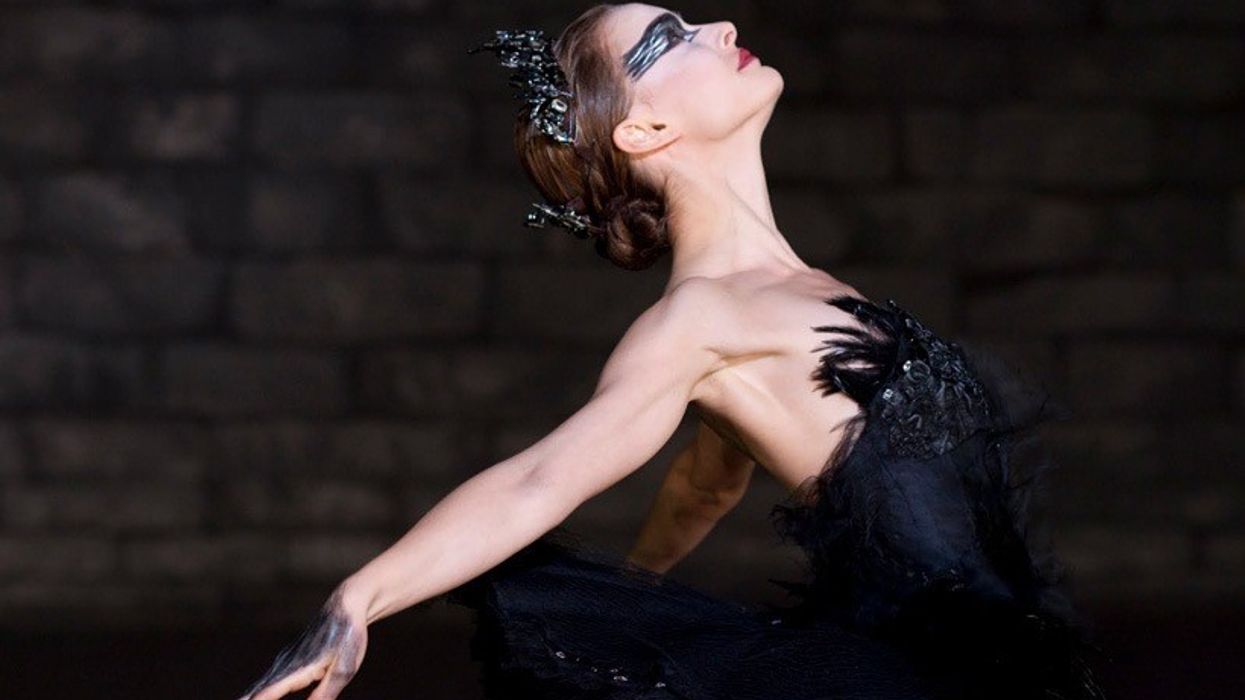
The psychological thriller genre stands as a captivating cornerstone in both film and television, mesmerizing audiences with its complex narratives, deep character studies, and suspenseful twists.
Unlike traditional thrillers , which primarily focus on physical danger and high-stakes scenarios, psychological thrillers delve into the minds of their characters, exploring the darker, more intricate facets of human psychology.
Today, we'll unpack the psychological thriller genre, offering insights into its definition, characteristics, and standout examples from film and TV that have left an indelible mark on the industry.
Let's get started.
Psychological Thriller Definition
A psychological thriller is a genre that combines elements of suspense, thriller, and psychological fiction. It emphasizes the mental states of its characters, often incorporating themes of reality, perception, mind, and identity. These narratives are designed to elicit strong emotional responses from the audience, using tension, dread, and ambiguity to keep viewers on the edge of their seats.
Psychological Thriller Tropes
The Haunting of Hill House
Psychological thrillers, a genre celebrated for its exploration of the human psyche, employ a variety of tropes to captivate and unsettle audiences.
These tropes, or recurring themes and devices, are crucial in building suspense, developing characters, and propelling narratives. Here's a look at some of the most prevalent.
- Unreliable Narrator : This trope involves a narrator whose credibility has been seriously compromised. It keeps audiences guessing about the truth of the narrative, as the storyteller might be distorting reality due to mental instability, personal bias, or deliberate deception.
- Twisted Reality: Psychological thrillers often play with the concept of reality, using hallucinations, dreams, or altered perceptions to blur the lines between what is real and what is imagined. This can lead to a deep sense of unease and confusion, both for characters and viewers.
- Obsession : Characters in psychological thrillers frequently become obsessed with a person, idea, or object. This obsession drives the plot and leads to increasingly dangerous and erratic behavior, highlighting the dark side of human nature.
- Paranoia : Characters may feel an intense, irrational distrust of others, believing they are being persecuted or conspired against. This paranoia can escalate the tension in the narrative, leading to dramatic confrontations and revelations.
- Identity Crisis: Questions of identity are central to many psychological thrillers. Characters may struggle with their sense of self, experience identity theft, or encounter doppelgängers, leading to existential crises and confusion.
- Psychological Manipulation: This involves one character manipulating another for personal gain, revenge, or sheer enjoyment, often leading to a power struggle between the manipulator and their victim.
- Isolation : Characters are often isolated—either physically, psychologically, or both—heightening the sense of vulnerability and making the psychological aspects more intense. Isolation can be a literal confinement or a more metaphorical social or emotional detachment.
- The Descent into Madness : A common narrative arc involves a character's gradual descent into insanity, often portrayed through their perspective to immerse the audience in their deteriorating mental state.
- Moral Ambiguity : Characters in psychological thrillers often operate in a grey moral area, where right and wrong are not clearly defined. This ambiguity challenges audiences to question their own moral compass and the nature of justice.
- The Hidden Enemy: Unlike traditional thrillers that may feature a clear antagonist, psychological thrillers often present the enemy as hidden or reveal that the protagonist themselves may be their own worst enemy due to internal conflicts.
- Non-Linear Storytelling : The use of non-linear narratives can reveal key information about characters and events in a disjointed manner, creating suspense and gradually piecing together the mystery.
- Mind Games : Characters engage in psychological warfare, using intellect and deception to outmaneuver their opponents. This can involve complex plots, traps, and strategic misdirection.
- Complex Characters : Protagonists and antagonists in psychological thrillers are often deeply layered, with their motivations, sanity, or perception of reality coming into question.
- Plot Twists : The use of unreliable narrators, sudden plot twists, and non-linear storytelling techniques keeps audiences guessing.
- Tone : A dark, brooding atmosphere, complemented by a tone that emphasizes suspense and mystery, is pivotal.
Examples of Psychological Thrillers
This genre offers audiences deep, often unsettling insights into the complexities of the human mind and the mysteries of the human condition.
Let's look at a few examples you should check out.
Psychological Thriller Movies
The psychological thriller genre has given rise to some of cinema's most unforgettable films.
- Psycho (1960) by Alfred Hitchcock: Often cited as the progenitor of the psychological thriller genre, Psycho explores themes of identity, madness, and voyeurism. Hitchcock's masterful use of suspense and the unexpected twist has set a precedent for future thrillers.
- Fight Club (1999) by David Fincher: This film delves into identity, chaos, and the dissolution of society through the eyes of its disillusioned narrator, offering a critique of consumer culture while engaging in psychological manipulation.
- Black Swan (2010) by Darren Aronofsky: A haunting exploration of ambition, competition, and identity within the high-pressure world of ballet, Black Swan blurs the lines between reality and hallucination, creating an intense psychological experience.
Psychological Thriller TV Shows
The television landscape has also embraced the psychological thriller, producing series that explore complex narratives over longer periods.
- Breaking Bad (2008-2013): While primarily a crime drama, the series delves deep into the psyche of its protagonist, Walter White, exploring themes of power, corruption, and transformation in a suspenseful narrative.
- Mindhunter (2017-2019): This series examines the psychology of serial killers and the FBI agents tasked with understanding them, blending real historical cases with a deep dive into the nature of evil and obsession.
- The Haunting of Hill House (2018): A modern reimagining of Shirley Jackson's classic novel, this series explores psychological horror through the lens of family trauma, grief, and haunted memories, effectively using the supernatural as a metaphor for mental anguish.
The psychological thriller genre remains a vital and evolving component of film and television, captivating audiences with its exploration of the human condition.
Through a combination of suspenseful storytelling, complex characters, and thematic depth, these narratives challenge our perceptions and engage us on a deeply emotional level.
As filmmakers and TV creators continue to explore the vast landscapes of the human psyche, the psychological thriller genre promises to keep us enthralled, unsettled, and always questioning the nature of reality.
Let me know all about your mental anguish in the comments.
- Making a Digital-Age Thriller? Alice Seabright and 'Chloe' Can Teach You a Thing or Two ›
- 'Borg/McEnroe': Transforming the Great Tennis Rivalry into a 'Psychological Thriller' ›
- A Genre Examination of Psychological Horror Movies and TV Shows ›
- Psychological Thrillers | Netflix Official Site ›
- 20 Best Psychological Thriller Movies to Watch in 2023 ›
- Psychological thriller - Wikipedia ›
The Platonic Definition and Plato's Allegory of the Cave
Plato's allegory of the cave and the "platonic" definition will help your writing and directing shine. .
It's hard to believe the Ancient Greeks have anything in common with today's Hollywood, but the root of what we do here in film, television, web series, and shorts all harkens back to platonic times and the allegory of the cave.
But what is the "platonic" definition? and what does Plato's allegory of the cave have to do with modern cinema across the world?
Today, we're going to define platonic and look at why Plato's allegory of the cave matters to entertainers in every medium.
That's a big task—so strap in. We're going on an adventure, deep into the past, all the way back to the present. It turns out, we're all people living who want to leave the cave.
It's time to get into it all together and return to the cave.
What Is the Platonic Definition and Meaning in Plato's Allegory of the Cave?
The allegory of the cave, or Plato's Cave, was a story presented by philosopher Plato in his work Republic . It is written as a conversation between Plato's brother Glaucon and his mentor Socrates . It was meant to confront human nature.
Before we dig deep into the cave of shadows, let's talk more about this time period which we define by the philosopher at its center and the definition "platonic."
Platonic Definition
Plato's influence on the culture of the West was so expansive that several different concepts are called platonic or platonist.
Different Plantonic Meanings
- Platonic love: A relationship that is defined by friendship and not sexual desire.
- Platonic forms: Plato's model of existence that says the physical world is not as real or true as absolute, unchangeable ideas.
- Platonic idealism: The philosophical position that abstract objects exist objectively and outside of human minds.
- Platonic solid: The geometry term for a convex, regular polyhedron in three-dimensional Euclidean space.
- Platonic crystal: A periodic structure designed to guide wave energy through thin plates.
- Platonism: The philosophy of Plato which he espoused in the Classical Period.
- Middle Platonism: Philosophy derived from Plato (1st century BC to 3rd century AD).
- Neoplatonism: A philosophic school deriving from Plato (starting in the 3rd century AD).
- Platonism in the Renaissance: An affirmation of the existence of abstract objects in a third realm distinct from both the sensible, external world and from the internal world of consciousness, seen as the opposite of nominalism.
"Platonic" Defined
Basically, "platonic" means everything associated with the Greek philosopher Plato or his ideas.
Who Was Plato?
Plato was a famous Greek philosopher. He was born in Athens during the Classical period in Ancient Greece. He was a student of Socrates, and eventually, he taught classes to Aristotle. He had platonic relationships and a close friendship with both.
He also founded the Platonist school of thought. That school of thought was taught at the Academy, the first institution of higher learning on the European continent. And many of the things Plato taught formed the basis for Western and Middle Eastern philosophies.
The thing Plato is most famous for is his allegory of the cave.
What is the allegory of the cave?
Plato's Allegory of the Cave Summary
The allegory of the cave, also known as Plato's Cave, is a story in which there are prisoners in a cave.
They have been there since they were babies, and know no world outside of being chained inside the cave. They cannot turn their heads. They can only stare at a wall where shadows dance.
A fire burns behind them, providing light for the shadows. Between the fire and the prisoners chained, there is a parapet, along which puppeteers can walk. The puppeteers are carrying objects and use puppets that cast shadows on the wall of the cave.
No prisoner can see a puppet or puppeteer, only the shadows. And they can only hear the echoes cast by objects that they do not see.
Therefore, the prisoners, with no other knowledge, think the shadows they see are real. But it's not reality, only the appearance of reality.
So if a prisoner talks about a bird or a dog, they are really talking about the shadow and not the actual thing.
There's an interesting theory about reality here and how it is based on our perception and not actually the facts of the real world.
It is not until the prisoners are released that they realize the fallacy of their thoughts and the actuality of the world.
Quotes from the Allegory of the Cave
You've read the summary, now check out some of the best platonic quotes from the allegory of the cave. All of these come directly from Plato's writing in Republic , which we will get to later.
- “It is the task of the enlightened not only to ascend to learning and to see the good but to be willing to descend again to those prisoners and to share their troubles and their honors, whether they are worth having or not. And this they must do, even with the prospect of death.”
- “Anyone who has common sense will remember that the bewilderments of the eyes are of two kinds, and arise from two causes, either from coming out of the light or from going into the light.”
- “Whereas the truth is that the State in which the rulers are most reluctant to govern is always the best and most quietly governed, and the State in which they are most eager, the worst.”
- “It is the duty of us, the founders, then, said I, to compel the best natures to attain the knowledge which we pronounced the greatest, and to win to the vision of good, to scale the ascent, and when they have reached the heights and taken an adequate view, we must not allow what is now permitted. What is that? That they should linger there, I said, and refuse to go down again among those bondsmen and share their labors and honors, whether they are of less or of greater worth.”
- “How could they see anything but the shadows if they were never allowed to move their heads?”
Plato's Cave Explained
As I mentioned, it has to do with the platonic idea of perception versus reality. The prisoners only know the world we present them, and nothing else.
The things we show them—books, dogs, cats, ships, or anything—aren't defined by their names, but by how they think they work.
Plato claimed that knowledge gained through the senses is no more than opinion and that, in order to have real knowledge, we must gain it through philosophical reasoning.
According to Plato, the path to enlightenment is not easy, and it has four stages:
- Confinement in the cave (our imaginary world)
- Release from the bindings (our real, senses-only world)
- The ascent outside of the cave (a new world of ideas)
- The journey back into the cave to free our friends
Analysis of the Allegory of the Cave
How can we explain the philosophy of Plato's Cave further? Well, the allegory gets at the center of what is truth, and how our different experiences and backgrounds allow us to perceive our shadows in our own way.
That being said, the shadows are changing all the time, so there is no consistency for those who see them, only a false reality given to us by our perspective.
The allegory of the cave, or Plato's Cave, was presented in his book The Republic . to compare "the effect of education and the lack of it on our nature."
The Republic by Plato Summary
Another one of Plato's famous writings was Republic, which was a self-authored book containing conversations with Socrates about justice, order, and character.
It challenged a person's place within society and within themselves, offering up ideas on how they should behave to benefit the whole.
All this dialogue happens during the Peloponnesian War, which makes it very poignant. At its center is the question of whether or not a just or unjust man can be happy, given the choices they have to make in life.
Republic is probably Plato's best-known work outside of the allegory of the cave, and it is one of the world's most influential philosophy and political theory books ever written.
What Do the Platonic Definition and Plato's Cave Allegory have to do with Hollywood?
The idea of Plato's Cave has been used extensively in storytelling, from movies like The Matrix, The Truman Show, The Village, Shutter Island, and The Island , to TV shows like LOST , Legion , and even parts of Mad Men. They all take inspiration from the allegorical concept.
Sometimes, philosophy and filmmaking collide. Much of storytelling is approached from a platonic point of view.
When you get an audience in the seats of a theater or on their couch, or even reading your screenplay, they are prisoners in your cave.
Your writing, direction, and storytelling casts the shadows and allow you to change their reality. You can tell a story about a man who can fly or a woman who is half fish and uses a fork as a comb.
Give them the shadows. If they accept your reality, they'll enjoy your work. But if you reject it, you're in a lot of trouble.
Summing Up The Platonic Definition
Whether you have a platonic friendship with Plato's work or a close relationship with his philosophy, I think this stuff can help your work in film and television to no end.
Not only does it bring up important questions and ideas, but it also challenges you to be the shadows on the wall, entertaining people and bringing new perspectives and ideas to them.
If you have thoughts or comments about the platonic definition or Plato's cave, let me hear about it in the comments.
I can't wait to see what it inspires within you.
The 'Longlegs' Ending Explained
The ending of 'shutter island' explained, what are the best mystery movies of all time, turn your smartphone into an ai-powered micro-four-thirds camera, most screenwriters don't know the nutshell technique, defining the psychosexual thriller genre, learn the secrets of perfecting parody with 'challengers' spoof "putters", 'cuckoo' and 'the nice guys' producer ken kao wants more mid-budget films, how craig tollis used adobe premiere pro, adobe after effects and adobe photoshop for the award-winning film “love & taxe$”, how to score a video game.

- Schedule an Appointment
- About Rachelle Ramirez
- Editing Services
- Search for...
How to Write a Thriller, Part One
- by rachelle
- November 4, 2018 March 23, 2019
Are you writing a Thriller; a story in which the protagonist is negotiating a complex world, struggling at the limits of human experience, and triumphing (usually) over seemingly overwhelming forces of antagonism? Maybe you’re confused about the difference between a Thriller story and a Crime, Action, or Horror story. Want to know if you’ve hit all the obligatory scenes and conventions of your genre?
In this article I’ll walk you through the fundamentals of the Thriller and compare and contrast it with certain aspects of Horror and Crime. In Part Two, I’ll go deeper with those comparisons and demonstrate the differing obligatory scenes and conventions of all three of these closely related genres.
First, let’s clear up some misconceptions.
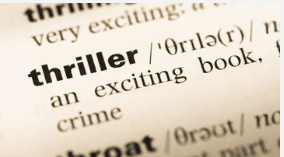
Many writers confuse the Thriller Genre with the Horror or Crime Genres due to the many obligatory scenes and conventions these genres share. According to the Story Grid, the Thriller contains elements of the Horror Genre, although Robert McKee, in Story , disagrees. You might want to read the articles I wrote on Crime , Action , and Horror as a primer for this article.
What is a Thriller?
“ The Thriller is an arch-plot (Hero’s Journey) external genre combining the primal genres (Action, Horror, and Crime)…. The thriller…concerns the individual coping with omnipresent and often difficult to even comprehend antagonism. The external becomes internal, forcing the protagonist to make fundamental choices to unleash critical gifts..” —Shawn Coyne
The Thriller is about excitement and the need to avoid both death and damnation. While Crime stories usually end at justice or injustice, and Horror and Action stories usually end at life or death, the Thriller protagonist is pushed to their limits. Toward damnation.
So the Thriller arc is Life to Cognitive Dissonance to Death to Damnation (a fate worse than death).
A Thriller need not reach actual damnation, but the potential and the vehicle for damnation must be expressed.
What is the core emotion?
Every genre has a core emotion; the reason audiences are attracted to the type of story you’re telling.
The c ore emotion in the Thriller is e xcitement.
People choose a Thriller to experience thrills without risk. Depending on the additional internal genre, the reader is also likely to feel relief or satisfaction as the protagonist learns what is essential in time to avoid disaster.
What is the controlling idea?
A story’s controlling idea (sometimes called the theme) is the lesson you want your reader to come away with. It’s the meaning they will assign to your story, usually unconsciously. A controlling idea can be stated in a single sentence that distills the argument your story attempts to make through narrative.
It’s made up of the big value change at the climax of your story, plus the specific cause of that change.
If your Thriller is a prescriptive or positive story about what we should do, your controlling idea will be something like: Life is preserved when the protagonist unleashes his or her special gift.
If it’s a cautionary or negative story about what we shouldn’t do, your controlling idea will be something like: Death or damnation triumphs when the protagonist fails to unleash his or her special gift.
Editor Tip: Don’t worry if the controlling idea of your story is generic as well. Readers will never see this statement. The important thing is that you have a guide for your story. Controlling ideas are your compass. When in doubt about where your story should go next, review your controlling idea.
What are the obligatory scenes?
Obligatory scenes are “must-have scenes for paying off readers’ expectations as set up by the conventions of the genre.”
In any genre, if you leave out an obligatory scene for that genre, you’ll have a story that doesn’t work.
The obligatory scenes of the Thriller are:
There is an Inciting Crime indicative of a master Villain . There must be a victim and a perpetrator (even if they are the same person, as in Fight Club ). The victims can be hostages, dead bodies, missing persons, or the assaulted.
There is a clear “point of no return ,” the moment when the protagonist knows they can never go back to the way things used to be. There must be a precise moment when the protagonist’s world is knocked out of alignment .
The protagonist’s initial strategy to outmaneuver the antagonist fails .
The protagonist discovers and understands the antagonist’s external object of desire , what the antagonist wants.
The Protagonist becomes the victim . A scene reveals that the antagonist makes their crimes personal to the protagonist and the protagonist becomes the primary victim.
The core event of the Thriller, the All-is-Lost-Moment, is when the Hero is at the Mercy of the Villain in which the protagonist sees the antagonist as unbeatable and the protagonist unleashes their gift.
Editor Tip: This is a difficult scene to innovate. Compare as many Thrillers as you can to find new ways of putting the protagonist at the mercy of the antagonist.
There is a False Ending . After a scene that seems to mark the resolution, the antagonist rebounds to challenge the protagonist again.
What are the conventions?
Genre conventions are elements in the story that must be there or the reader will be confused, unsettled, or bored. Without them your story won’t work. Conventions, unlike obligatory scenes, are specific requirements for a story’s characters and/or methods of advancing plot. They can be turning points and do not necessarily have to be implemented in any certain order.
Derived from the Crime and Action Genres, all conventions in the Thriller need to support the value at stake of Justice and Injustice.
The conventions of a Thriller are:
The atmosphere is portrayed in considerable detail, becoming alive and immediately threatening.
The antagonist has an object of desire, what they want.
Editor Tip: The want must be plausible and valuable object of desire that will push the characters to obtain and fight for it. This could be nuclear codes, the cache of diamonds, money, etc. The object of desire must tie into the story logic you’ve built be a believable want of the antagonist and relate, in some way, to the protagonist’s internal genre arc (if they have one). As a story driver, the quest for the MacGuffin must create conflict, tension, and emotion.
The inciting crime must contain a clue about the villain’s object of desire.
The antagonist makes their actions personal to the protagonist : The antagonist must victimize the protagonist in order to get what they want.
Derived from the Action Genre, there is a limited time for the protagonist to act (Clock). If the protagonist doesn’t conquer the antagonist, the antagonist will get what they want by default. The clock defines the limits of the story and whether the protagonist will succeed or fail.
The protagonist actively investigates and chases clues (including false leads/red herrings) in order to find or trap the antagonist. In other words, the protagonist’s goal is to render the antagonist useless by solving a crime or a puzzle.
Editor Tip: Red herrings should be compelling enough to lead the protagonist away from the antagonist, but the protagonist must ultimately identify them as irrelevant. Red herrings are progressive complications that add tension to the story while challenging the reader’s ability to solve the puzzle ahead of the protagonist.
Lives depend on the protagonist defeating of the antagonist .
The story contains elements of suspense. Suspense is a form of narrative drive where the audience and the character know the same amount at the same time. The audience is kept in perpetual discomfort because the antagonist seems to attack randomly and never rests.
The antagonist can’t be reasoned with. They are intent on annihilation, devastation, or power at the expense of others.
There is a speech in Praise of the Villain : The cunning or brilliance of the antagonist must be praised by one or more characters or shown in a revelation.
Editor Tip: The speech in praise of the villain is an easily misunderstood convention. I like the way Story Grid Editor, Anne Hawley, clarifies it: “The speech, once the province of the evilly-laughing Bond villain praising himself, has morphed and become much more subtle in modern works.” It can be as small as a secondary character pointing out that the antagonist is far more powerful than the protagonist. Or it might be the protagonist themselves stating, during an all-is-lost moment, that they can’t beat the antagonist for a particular reason.
The protagonist is the final victim . Similar to the Horror Genre.
There is a clear threat of escalating danger , even if the danger is limited to the psyche of the protagonist, in a cause and effect chain of events.
There is at least one shapeshifter or hypocrite character capable of directly impacting the protagonist.
Editor Tip:This is a secondary character who says one thing and does another. Usually this character first appears as a helper and then becomes a hinderer, but this can be reversed. The shapeshifter’s levels of antagonism can vary greatly between characters and stories.
In a prescriptive Thriller, the antagonist must be brought to justice. In a cautionary Thriller, injustice prevails.
Editor Tip: Justice can mean death, banishment, or imprisonment. Conversely, the antagonist can get away (injustice), especially in a series, but the protagonist must be either dead or out of immediate danger with some sense of victory (win but lose, win for now).
What are the subgenres of the Thriller Genre?
Thriller subgenres are usually determined by the setting, so there can be a great deal of overlap between one subgenre and another. Don’t get bogged down with this. The more you study these subgenres and analyze their boundaries against contemporary stories, the less distinct they will seem. In time, perhaps, the subgenres will evolve or degrade and render this list antiquated. I like to think of these as plot devices rather than subgenres:
Serial Killer : Examples of this story are Red Dragon and Silence of the Lambs.
Medical: Examples of this story are Coma and The Andromeda Strain.
Legal: Examples of this story are And Justice for All, Sleepers, and Mississippi Burning.
Psychological: Examples of this story are Primal Fear, Gone Girl , and Fight Club.
Espionage: Examples of this story are The Bourne Identity, Three Days of Condor, and The Hunt for Red October.
Person in Jeopardy: Examples of this story are The Client, Ransom, and Sleeping With the Enemy.
Erotic: Examples of this story are Basic Instinct, Fatal Attraction, and Twilight.
Military : Examples of this story are Seven Days in May and The Jack Ryan Universe Series.
Political : An example of this story is Marathon Man .
Journalism : Examples of this story are The Scarecrow, The Post, and All the President’s Men.
Financial: Examples of this story are Numbered Account, Not a Penny More, Not a Penny Less , and Black Fridays.
Hitchcock: Examples of this story are A Coffin for Dimitrios and North by Northwest.
Editor Tip: Read and watch the masterworks that use your chosen plot device and analyze them for additional conventions and tropes.
What about audience expectations of the Thriller?
Remember, you’re writing a story that incorporates aspects of the Action, Crime, and Horror Genres (and, in the case of Erotic Thriller, also includes a Love story).
A Thriller need not have much action or many horrific scenes. Don’t be afraid to slow your story down to illuminate the antagonist’s object of desire, to get sidetracked with the false clues, and to let the protagonist make some serious mistakes. Allow tension to ebb and flow. Keep your reader asking questions.
In Part Two of this article, I’ll demonstrate how the controlling ideas, global values, obligatory scenes and conventions differ between Thriller, Crime, and Horror.
Why do internal genres go well with a Thriller?
The best Thrillers have an internal genre arc for the protagonist. But they aren’t required.
Editor Tip: Not all of the obligatory scenes and conventions of the internal arc need to be met. Incorporate most of them into the scenes of the Thriller primary story rather than creating scenes stand alone scenes for the secondary genre.
For your internal genre, choose a conflict important to your characters. A character’s investment in an outcome increases investment from the reader.
If your protagonist is knowingly doing wrong, consider the Morality Genre for their internal arc.
If your protagonist is making the wrong choices or assumptions because of their immaturity, lack of knowledge, and/or naivete, consider the Worldview Genre for their internal arc.
If your protagonist is trying to fit in, gain an improvement in (or maintain) their financial, professional, or social rank, consider the Status Genre for their internal arc.
If you are writing a series, consider starting your protagonist closer to the bottom of Maslow’s Hierarchy of Needs and have them move their way up a notch in each book to keep them moving forward internally.
Determine the want and need of your antagonist. How are they related to the want and need of the protagonist? What does the antagonist really want? These wants and needs will drive your story and determine your internal genre. Create dynamic protagonist and antagonist characters with opposing goals.
Additional notes on writing the Thriller:
On characterization:.
Show us how your protagonist reacts instead of telling paragraphs of their thoughts. Ground the reader in scene with scent, touch, sounds, gut reactions, and dialog. Characterization is not what the protagonist is thinking. It’s demonstrated in their actions.
Editor Tip: Having trouble with characterization and pacing? Resources worth examining are Writing with Emotion, Tension, and Conflict and The Emotional Craft of Fiction .
On moving to the next level in your writing:
Read widely in the Thriller Genre and compare your work to the masterworks and the guidelines here. The best way to move toward innovation is knowing what others have already done.
Now you have the basics of the Thriller and are primed to finish that story. When you’re ready for an editor, please contact me for a free 30-minute phone consultation on your work.
I wish you the best with your writing.
You can read more blog posts I’ve written with these links:
How to Write a Thriller, Part Two , How to Write a Performance Story , How to Write a Morality or Redemption Story , How to Write a Status Story , How to Write the Worldview (Coming of Age) Story , How to Write the Rebellion Story , How to Write a Memoir , How to Write an Action Story , How to Write a Crime Story , How to Write a Horror Story, How to Write a Western, How to Write a War Story. How to Write a Big Idea or Self-Help Book
Special thanks to Anne Hawley for editing this post.
A version of this post first appeared in the Story Grid, Fundamental Fridays blog series as Secrets of the Thriller Genre, Part One.
About the Author
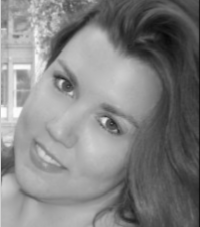
Rachelle Ramirez helps writers develop their stories and believes stories are our most important catalyst for change. She received an MA in psychology from Goddard College and attended the School of the Art Institute of Chicago’s Masters in Creative Writing Program on merit scholarship. Rachelle served as the executive director for a national writing community before becoming a Certified Story Grid Editor. She is honored to have edited the award winning fiction of some amazing authors but her favorite work is with first-time novelists and memoir writers. She is easily bribed with promises of iced coffee drinks, piles of puppies, and long walks in thunderstorms. She is currently on contract, writing a Story Grid Guide to a masterwork. Her forthcoming novel is White Grrrl, Black Sheep. Grab a spot on her calendar for a free 30-minute consultation on your story.
5 thoughts on “How to Write a Thriller, Part One”
I completely agree with what you have written. I hope this post could reach more people as this was truly an interesting post.
Thank you Paul! I’d love to share these ideas with more writers.
Thanks for sharing this great article Rachelle! Very well-written! Cheers!
very nice and informative artical.
Thanks, Rahul. Are you writing a Thriller? Are you leaning more toward Crime, Action, or Horror?
Leave a Reply Cancel reply
Your email address will not be published. Required fields are marked *
Currently you have JavaScript disabled. In order to post comments, please make sure JavaScript and Cookies are enabled, and reload the page. Click here for instructions on how to enable JavaScript in your browser.
- Skip to main content
Michael Santos
The official website of crime fiction author Michael Santos.
How to Write a Thriller: The Keys to Suspenseful Writing
December 22, 2018 by Michael Santos
In this article, we begin discussing thriller novels by talking about suspense. How do we create suspense? How does it work within a crime novel to create a satisfying experience for readers?
Be sure to watch my YouTube video on this subject as well.
It’s all about mood.
The label “thriller” encompasses a wide variety of fiction. In terms of popular genres, you’re likely familiar with legal thrillers, psychological thrillers, historical thrillers, and many more.
It is one of the most versatile types of book, because any story can contain elements of a thriller. That is to say, any story can be thrilling. As a result, they are incredibly fun to write, because thriller authors have a great deal of freedom in terms of subject matter, story structure, and the mechanics of the creative writing craft.
The key to every thriller is having the right mood, which demands that you create suspense for the reader.
How do we write with suspense?
I define good suspense as a combination of excitement and apprehension . I want to be desperate to know what happens next in the book, but I also want to experience a sense of dread.
You have to make the reader worry about the outcome of the story. Each new plot point has to change the game in such a way that the reader says, “Uh-oh, now what?” You should make your reader hope for a happy ending but fear impending doom for the characters.
The narrative in a thriller is built on layers of twists and turns that create both excitement and apprehension. Each layer changes the status quo in such a way that the reader senses the tension building, which makes them wonder when that tension will become too much. They instinctively know that the story can’t go on like that forever.
These layers build to an ending that pays off those feelings, arguably the most important part of a thriller–the end is the most cathartic stage of the reading experience, when the emotions are at their peak.
Writing with suspense entails creating, managing, and escalating that sense of impending disaster, as the narrative progresses from its inciting incident to the climax, at which point the protagonist’s life will be irrevocably changed.
There will either be a happy ending (what the reader hopes for), a negative ending (what the reader dreads), or a mix of the two. Perhaps an FBI agent catches the serial killer, but must compromise her personal values and identity to do so. Those complicated resolutions are the ones that will resonate with readers the most, because they keep you thinking long after you finish the novel.
The resolution in a thriller must be both surprising and inevitable. It must shock the reader. At the same time, when the reader considers the story in retrospect, the ending must make complete sense. With the benefit of 20/20 hindsight, they should feel like they should have seen the end coming all along.
Thrillers are built on hope.
To write a compelling thriller, you must manage the reader’s hope and fear. But how?
One of my favorite techniques is dramatic irony , when the reader knows more than the characters.
The most common example of this is found in horror movies, when a clueless character goes down into the dark basement. The viewer knows that the monster is down there, ready to rip asunder the poor soul’s head. But the character believes they’re making the right decision.
This creates a powerful sense of impending doom. We hope that they survive, but we dread the likely possibility that we’ll be saying goodbye to this character in a matter of seconds.
Another example…
In my first novel, No Hard Feelings , my protagonist–a hit man named The Apostle–believes the woman he’s seeing has betrayed him to the police and to a group of criminals, who want revenge for a crime he committed against them.
Chapter 11 opens with the woman–Eve–driving home from a date with another man, a detective no less. She’s feeling positive after meeting with him. The next scene shows The Apostle breaking into her apartment, where he plans to confront her about her alleged treachery. He’s irate, hurt, and desperate. And he’s a professional killer.
Eve has no idea that he’s waiting for her, but the reader does.
When you get to that scene, you hope that their encounter will end peaceably. But you dread more negative outcomes.
That’s how dramatic irony works. It plays on the reader’s hope and fear.
Hope is built on good characterization.
It is essential that your reader connects with the characters for this to work. It is required, or your thriller will be less than satisfactory and contain no emotional power whatsoever.
Read It , by Stephen King–a masterpiece of characterization. We get to know the Losers’ Club by seeing the intricacies of their dreams, apprehensions, and lives as both children and adults. The horror plot points in the novel are compelling and terrifying, because we become close enough to the characters for us to feel their dread along with them.
We hope and fear because they do, and King’s skill in creating and developing engaging characters is the key to that.
How to write characters that resonate with readers.
This subject is worthy of its own post (or series of posts), but I’ll keep it simple in this article.
Thrillers are known for their action-packed plots. In any story, there is an external narrative and an internal narrative . The thriller genre is driven by the external; that is, the events of the story–the conflict surrounding the characters.
But it’s the internal narrative, the conflict within the characters, that binds the reader to them on a human level. The internal conflict speaks to a human experience that we’ve all had or will have.
What makes this even more interesting is that it’s common for the reader to know what a character’s internal conflict is…but often the character does not. They typically learn it by the end, in a moment of revelation. “I thought I wanted x , but I needed y all along.”
The internal narrative also enhances our experience with the external narrative, because it adds to the plot’s stakes.
For example, let’s go back to that FBI agent/serial killer bit. The agent’s external objective is straight-forward: they want to solve the case. The plot of the novel will be built on that objective, as we follow the agent’s progress.
But what about the internal objective? Perhaps the FBI agent must solve this case to make up for some horrible thing they did in their past. Now the stakes are much higher. It’s not just a story about stopping a serial killer. The protagonist’s entire sense of self and subconscious journey for redemption now rides on the outcome of the case.
We’ve all experienced a time in life when we sought redemption, so we relate to that story. We hope that it resolves in the agent’s favor, because if they can find redemption, surely so can we. But we dread the negative ending, because we feel the same doom as the character.
For more information about external and internal conflicts, read the full article on how to use them effectively in your story writing .
Back to No Hard Feelings .
In my novel, The Apostle faces two tremendous conflicts in the scene where he breaks into Eve’s apartment.
The external conflict: he’s on the run from the police and a gang, and the woman he loves may have sold him out. The internal conflict: his father used to mercilessly beat him as a punishment. He became a hit man, a professional murderer, so that he would always be the most dangerous person in the room. So that no one could ever hurt him again.
The fact that the woman he loves is likely hurting him is too much for him to handle. It brings him back to his childhood, when another loved one caused him emotional (and physical) pain. He constructed his whole adult persona to avoid such torture, and now that persona is failing him.
He must find the truth about Eve for the sake of his sense of self, his identity, and his ability to find peace. All of which adds to the stakes of the external events in the chapter.
Because of that strong internal narrative, the reader feels connected to him and is more invested in the outcome of the scene. On top of that, the reader has spent enough time with Eve by this point in the story (chapter 11, remember) to know what her internal conflicts are.
When the two characters are in a scene of conflict together, the reader desperately hopes they’ll find happiness, while also dreading the opposite. In short, the chapter is suspenseful because it resonates with the reader on a human level.
Okay, let’s review. To write a good thriller:
- You must write with suspense.
- Suspense is a combination of excitement and apprehension, hope and fear.
- Dramatic irony is a great technique for creating suspense.
- You must get your readers to connect with your characters for them to feel hope and fear.
- To make that happen, write compelling internal narratives that add to the stakes of your plots.
If you enjoyed this post and found it helpful, please share it!
Subscribe to my author newsletter for a free book and more writing and crime fiction content!
Looking for a new thriller?
Check out my supernatural thriller, The Nowhere Game !

The Nowhere Game
How To Write a Thriller Novel: Step-By-Step
Thrillers are a popular genre in fiction and, if done correctly, almost guaranteed to find an audience. But not everyone can write fiction properly. So here’s how to write a thriller novel like a pro.
It’s probably the most well-known story of them all. A tale of good versus evil. The good guys versus the bad guys. Fighting against high stakes and insurmountable odds. The ticking clock, bombs going off, the bullets flying, and glamorous spies in tuxedos drinking Martinis.
Sounds familiar? Well, it should. The thriller genre – and its related subgenres – have been around since the beginning of fiction, and Hollywood screenwriting adaptations have also popularised the genre. As a result, readers love nothing more on their Kindle than a good thriller storyline that leaves them on the edge of their seats, biting their nails as the hero or heroine races against the clock to save the world from imminent catastrophe.
Types of Thrillers
Legal / crime thriller, political thriller, historical thriller, spy thriller, 1. flesh out your main characters, 2. start with a bang to hook the reader, 3. include plenty of plot twists and turns, 4. take inspiration from movies, 5. look at what’s going on in real life, 6. avoid really unrealistic scenarios, 7. keep the pacing and dialogue brisk and snappy, 8. set up high stakes and an amazing climax, the final word on how to write a thriller novel, what’s the difference between a thriller and suspense, what are the key elements of a thriller.
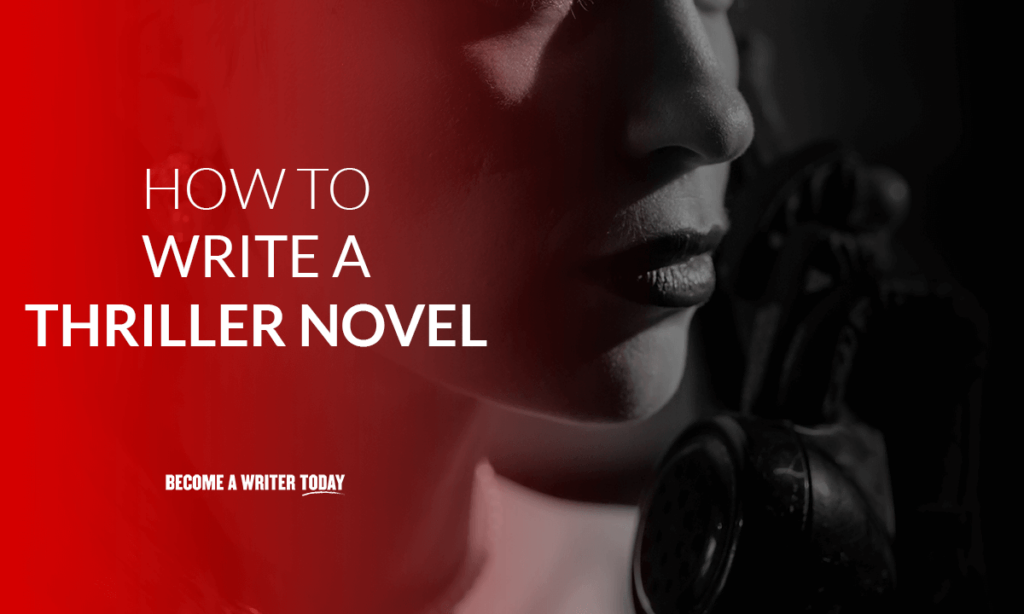
Thriller writing takes skill – and not everyone can pull it off. It’s one of the most challenging forms of creative writing to get right. Even after 17 spy thriller novels, I’m still in the learning process of refining the perfect thriller novel. But if you follow these tips, you’ll be well on your way to emulating great thriller bestsellers such as The Bourne Identity .
First, we should specify what types of thrillers are out there. It’s worth pointing out from the outset that “thriller” has arguably a wide-ranging definition. Any story genre which generates excitement, adrenaline, and a heightened heartbeat can be seen as a thriller. So technically, science fiction, mystery novels, and crime fiction can fall under the thriller category.
I’m sure you’ll agree that Hannibal Lector pitting wits against the FBI in The Silence of the Lambs would count as a thriller. So would Sherlock Holmes foiling Professor Moriarty’s latest devious plot. Even though they would likely be categorized as horror and crime, respectively.
Here are the five main types of thriller novels you’ll find today on bookshelves.
You might also be interested in learning how to write a quest story .
Psychological Thrillers
This is probably one of the most popular types of thrillers of all and the subgenre most likely to find its way onto the Hollywood big screen. Gone Girl immediately springs to mind , which starred Ben Affleck in the main character role.
Everyone loves a nail-biter, and a psychological thriller can easily have crossover with the horror genre (again, The Silence of the Lambs being the classic example).
John Grisham thoroughly dominates this is the corner of the thriller market. With bestselling books such as The Firm and A Time To Kill , Grisham has proven time and time again that the law can definitely co-exist with the thriller genre. Hollywood agrees, which is why most of Grisham’s books are now successful movies.
In the crime thriller sub-genre, the best examples that come to mind are Stieg Larsson’s Girl With the Dragon Tattoo trilogy and Thomas Harris’s Hannibal Lector trilogy. An older but more classic example would be Raymond Chandler.
Political thrillers are unique in the sense that they are almost always confined to US politics. Rarely do you see a political thriller set in other countries. The author that comes most to mind with political thrillers is James Patterson , who is now collaborating with former US President Bill Clinton.
Former Georgia Governor candidate Stacey Abrams has also brought out a political thriller called While Justice Sleeps , which shows that politicians are not afraid to use their experience to try and churn out a thriller novel or two.
A historical thriller can also be classed as a war thriller, with spy thrillers set during World War II especially popular. So as you can see, there’s a lot of crossover between sub-genres.
Historical thrillers are any story set in a specific historical period. Examples include authors such as Ken Follett, C.J. Sansom, Hilary Mantel, Robert Harris, and Alan Furst. Even horror writer Stephen King got in on the act with his alternative history thriller about the JFK assassination, 11.22.63 .
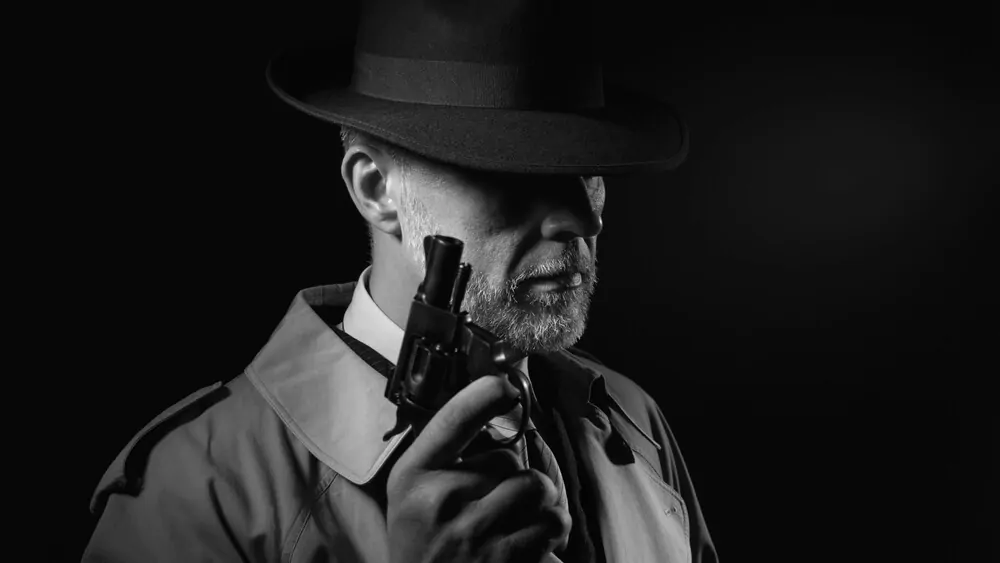
Spy thrillers (or “espionage” to use the proper name of the genre) is also an extremely popular thriller genre and the one I decided to specialize in with my Department 89 series. Spy thrillers have been written for more than a hundred years by the likes of Joseph Conrad and John Buchan. However, these days, the ones dominating the genre include Tom Clancy, Daniel Silva, Charles Cumming, Steve Berry, Ian Fleming, and Robert Ludlum.
However, Clancy, Fleming, and Ludlum are all now dead, with their work being continued by trusted ghostwriters .
The 8-Step Manual To Writing a Good Thriller
Let’s now take a look at the different ways to write a really good thriller.
Nobody likes one-dimensional, stereotypical, bland characters. If the reader doesn’t connect emotionally to the characters, they won’t feel the need to keep going with the story because they simply won’t care what happens to them.
So for each of the main characters, you need to flesh out and develop their characters and backstory. Every successful thriller has relatable and believable characters who have motivations, weaknesses, ambition, flaws, and ego. You need to introduce each of them to the reader gradually, so by the end, the characters become almost like good friends – even your villain.
What you should not do, however, is give the reader an “info dump” where you attempt to give all the pertinent character information in one go in one book. This slows down the story and kills momentum. Instead, it’s much better to spread the information over a series of books, perhaps in the form of flashbacks.
One trick I often employ when introducing a new character is to visualize what actor would theoretically play the character in a movie or TV version of your book. Then I develop dialogue and mannerisms based on how that actor usually acts on-screen. I find it makes the character more real to me.
This is what I call the “Bond effect” – at the start of every James Bond movie, there is an opening sequence which launches the viewer right into the action. More often than not, the opening sequence is entirely unrelated to the actual story – it’s just there to grab people’s attention and get everyone fired up.
For example, who can forget the infamous opening scene in Casino Royale when Daniel Craig remembers his first sanctioned kill in a bathroom? After watching it, nobody could stop watching.

In thriller books , you MUST hook your reader from the very first page. Otherwise, you’re going to lose them very quickly. So from the first time they open your book, the opening scene has to suck them in, so they keep turning the pages. I employ this tactic in all my spy thriller books to great success.
Another thing nobody likes in books is for the storyline to be absurdly easy. Anti-climatic plots are always going to annoy a reader who has invested time and money in your book. So throughout the story, everything has to appear hopeless and against the odds, only for your good guys and girls to pull it off at the end.
Whether it’s an uncatchable serial killer, a hidden bomb about to release a deadly plague, or a hostage situation, never let up on the challenges and the tension. Put in lots of plot twists, so just as the reader thinks they’ve worked out what’s going to happen, you turn a hundred and eighty degrees and surprise them.
Despite what some people may tell you, it isn’t plagiarism to be inspired by the movies. If you’re stuck and unsure how to proceed with your story, think about some related movies you’ve seen lately. Did they have some great scenes that stick out in your mind? Could you incorporate elements of that into your story?
Subconsciously, I’ve often found myself inserting elements of movie scenes into my thriller books. For example, parts of the famous car chase scenes in The Bourne Identity and Ronin have got into my books when I’ve had car chase scenes myself.
If the movies don’t help with story ideas or plot problems, then how about real life? Watching the news, for example, can give you a wealth of ideas. Whether it’s criminal activity, terrorism, or politics, seeing things unfold in the real world can often make you wonder, “what if that were to happen in my book? How would my version of the event play out?”
Some readers don’t like “grabbed from the headlines” plots, but if done properly with a compelling story and a suitable number of twists, the newspaper could be your new best friend.
Anyone who has ever watched an Arnold Schwarzenegger movie will know what I mean here. I’m talking about someone holding onto the side of a jet fighter as it whizzes through New York. Then, ripping off the cockpit window, grabbing the pilot, shooting them, and throwing them out, before finally jumping into the moving plane themselves and taking over the controls.
I’m all for escapist fiction, and I’ve had a few plots which may have stretched credibility just a tad. But there’s stretched, and then there’s ultra-stretched. If you write something ridiculous , it’ll annoy the reader and ruin your credibility as an author.
Another thing that ruins a perfectly good thriller book is when the story slows down to a snail’s pace. This could be due to an “info dump,” or you’re trying your best to squeeze in all the loose ends before the end of the book. Either way, you don’t want to slow down the story. Keep the pace fast and constantly moving.
Snappy dialogue is also essential. The one thing I and many others love in a story is rapid-fire dialogue between characters. Whether it’s an argument between colleagues, the cop making the criminal realize they’re definitely going to jail, or a passionate monologue from your main character, getting the dialogue right is the most critical part of the book. So keep tweaking your draft until the dialogue sounds sensational.
One thing to remember while doing dialogue is to avoid slang, colloquialisms, and sayings that someone not from your country wouldn’t understand. If the reader has to reach for a dictionary to look something up, you’ve just spoilt it for them.
Every successful thriller is a page-turner, which means you need to set up the stakes to be high enough. You don’t want the reader to feel cheated when you build up the suspense only to present them with a damp squib at the end of the book. That’s one guaranteed way to lose a reader and get a negative Amazon review into the bargain.
So if you’re introducing a bomb, make it a nuclear bomb. If it’s a knife, make it a Samurai sword. If it’s a gun, make it the biggest baddest gun you’ve ever seen in your entire life. Go big or go home.
If you’re writing a series, the best tactic to employ is a cliffhanger which is guaranteed to have the reader buy the next book in the series (provided you’ve given them a good story so far). I do this all the time with my books, as I know from personal experience that there’s nothing worse than a rotten ending.
If you’re not writing a series, ensure that you’ve wrapped up all loose ends at the end and that the good guys have saved the day.
Writing a thriller is an art form, but like any art form, it can be mastered if you practice it. If you’re new to the genre, you need to read other thriller books in your chosen subgenre, study the elements that make the books work and don’t work. For example, study the dialogue and how sentences are phrased.
Once you think you’ve got it figured out, then start to write your own. All going well, you’ll eventually make it as a bestselling author, even though the competition is fierce (and getting fiercer by the day).
FAQs on How to Write a Thriller Novel
To be honest, there’s not a whole lot of difference. Both thrillers and suspense books provide tension, shocks, surprises, and excitement.
First of all, a good story with high stakes and a sense of “dread.” A likable protagonist is next, along with a believable and nasty villain. And everything should be underpinned with cliffhangers and a ticking clock plot.
Thriller Genre in Films Research Paper
- To find inspiration for your paper and overcome writer’s block
- As a source of information (ensure proper referencing)
- As a template for you assignment
The thriller genre is one of the lively and most exciting that scriptwriters prefer using. The genre is characterized by elicit moods it gives to the viewers. The thriller genre gives a heightened suspense reaction, anticipation, anxiety, excitement, and surprise. Thrillers keep the viewers on the hedge points of their seats as the plot nears the climax (An, 2019). The thriller genre’s major concept is covering up important information where elements gradually come out unexpectedly. This research paper aims to find more information on using the thriller genre in the artistic world, such as common movies and films.
Many people like watching thriller movies where much of character diversion has been evident for many years. Viewers are fascinated by the elements surrounding thriller films they like following. The first element that the paper discusses is the dynamism of characters (An, 2019). Dynamic characters are used in many ways, with the first being a positive character who revolves around the movie showing the goodness they possess (Song-hwa, 2020). On the characters’ dynamism still, scriptwriters introduce to viewers a negative character who appears to be the antagonist of the good guy portrayed.
The thriller genre’s dynamic characters pass through systematic internal changes throughout the entire storyline. They change for better or for worse, and in many examples, the main characters in the movies and any other literature are dynamic (Hella, 2019). A dynamic character is essential because they show the real-life transitions that come when people do not anticipate. Thriller genre enlightens viewers about the social issues that make changes on people.
In the film Wrong Turn 7, the hikers, such as Jen, Adam, Darius, are portrayed as friends but later on, it comes to emerge that the group was barbaric. The group led by Adam later kills one of their foundation members, an act that turns Jen as inhumane (Allen, 2021). Adam and Gary are close friends. However, it appears that Adam, who is portrayed as an admirable person, turns to be a wicked character and even crushes Gary with a rolling tree trunk, everyone expected Adam to be the advocate for humanity but the viewers are left shocked from the turn of events (Allen, 2021). The dynamism presented here is the change of relationship ties that is introduced at first.
The other element of the thriller genre is suspense, which promotes an intense level of anticipation and excitement to the viewer. One way to build suspense is to use time factor. It means the protagonist should be working against the clock, and the clock should be working for the antagonist. For example, in the film 24 Hours , Karen and Will have less than a day to flee away from their captors to protect their child from kidnapping. That appears to be impossible for them since they are the protagonists, hence finding themselves in a tough situation with time. Film writers use this element to capture the viewers’ full attention so that they follow the context and see what happens. To some extent, suspense is the key element behind viewer’s interest in a given film (An, 2019). Scriptwriters are mostly using suspense to drive the viewer into critical thinking of many occurrences in real-life situations and for optimum entertainment from the film.
Another element of the thriller genre used in many movies is the cat and mouse characters. When the viewer watches a thriller with cat and mouse games, it reflects the turn of events that occur basically due to change over time (Lee, 2017). For example, in the film Old Boy, a drunken character Dae-Su is kidnapped and put in an enclosed room that has no windows for one and a half-decade. The character is later released from imprisonment, which viewers do not realize. The event’s turn to show the cat and mouse game is when Dae-su tracks down the main accountable for his imprisonment (Lee, 2017). He fights frequent times and does not eventually like the feedback he sees and decides to maneuver in other ways.
Allen, N. Wrong Turn movie review & film summary (2021) | Roger Ebert. Rogerebert.com . Web.
An, J. (2019). The Korean mother in contemporary thriller films: A monster or just modern? Journal of Japanese And Korean Cinema , 11 (2), 154-169. Web.
Hella, T. (2019). Character archetypes: Aesthetic values in character design in Malaysia’s animated films. International Journal of Innovative Technology and Exploring Engineering , 8 (11S2), 242-245. Web.
Lee, S. (2017). “Hollywood and Beyond”: Genre hybridity and transnationality in the crime thriller films of the 1960s’ Korean Cinema. Journal of Popular Narrative , 22 (1), 51-89. Web.
Song-hwa, Y. (2020). Signaling effect and the influence of genres: Movie consumption on Chinese online video platforms. Global Fashion Management Conference , 2020 , 220-225. Web.
- "Noah" Film by Darren Aronofsky
- The Movie "Mean Girls" by Mark Waters
- Chinese Literature: Su Shi's Poetry
- Korean Reunification: Reaching a Compromise
- “Fight Club” Action Thriller by David Fincher
- Psychological Disorders in "American Psycho" Movie
- Black Sexual Freedom and Manhood in "For Colored Girls" Movie
- "American Gangster" Directed by R. Scott Review
- Film Storytelling and Technological Impact
- Greed in "The Treasure of the Sierra Madre" Film
- Chicago (A-D)
- Chicago (N-B)
IvyPanda. (2022, July 12). Thriller Genre in Films. https://ivypanda.com/essays/thriller-genre-in-films/
"Thriller Genre in Films." IvyPanda , 12 July 2022, ivypanda.com/essays/thriller-genre-in-films/.
IvyPanda . (2022) 'Thriller Genre in Films'. 12 July.
IvyPanda . 2022. "Thriller Genre in Films." July 12, 2022. https://ivypanda.com/essays/thriller-genre-in-films/.
1. IvyPanda . "Thriller Genre in Films." July 12, 2022. https://ivypanda.com/essays/thriller-genre-in-films/.
Bibliography
IvyPanda . "Thriller Genre in Films." July 12, 2022. https://ivypanda.com/essays/thriller-genre-in-films/.
Learning Materials
- Business Studies
- Combined Science
- Engineering
- English Literature
- Environmental Science
- Human Geography
- Macroeconomics
- Microeconomics
We all wish to be entertained by the stories we read. Sometimes we may seek something whimsical or fantastical. Sometimes we want an armchair mystery. Other times, we may want something more exciting, like a nail-biting thriller ! But what makes a good thriller? Known for its suspenseful plotlines and thrilling twists, this genre is characterized by its high stakes and non-stop action . From psychological thrillers that delve into the dark corners of the human mind to legal thrillers that keep you guessing until the final verdict, the thriller genre has something for every reader.

Create learning materials about Thriller with our free learning app!
- Instand access to millions of learning materials
- Flashcards, notes, mock-exams and more
- Everything you need to ace your exams
Millions of flashcards designed to help you ace your studies
- Cell Biology
A thriller evokes a sense of __________
A thriller is fast paced and packed with _______
True or False: a thriller can never overlap with other genres
The Red Dragon is an example of a genre overlap between thriller and ____ fiction
In a thriller, the protagonist is _________
In a thriller, the antagonist is ________
True or false: thriller fiction typically includes multiple points of view
In a thriller, the sense of dread is due to:
In which of the following thrillers is a woman imprisoned in a room with her 5 year old child?
Which of the following thrillers is a successful Netflix adaptation?
Review generated flashcards
to start learning or create your own AI flashcards
Start learning or create your own AI flashcards
- American Drama
- American Literary Movements
- American Literature
- American Poetry
- American Regionalism Literature
- American Short Fiction
- Literary Criticism and Theory
- Literary Devices
- Academic and Campus Novel
- Adventure Fiction
- African Literature
- Amatory Fiction
- Antistrophe
- Autobiography
- Biblical Narrative
- Bildungsroman
- Blank Verse
- Children's Fiction
- Chivalric Romance
- Christian Drama
- Cliffhanger
- Closet drama
- Comedy in Drama
- Contemporary Fantasy
- Creative Non-Fiction
- Crime Fiction
- Cyberpunk Literature
- Detective Fiction
- Didactic Poetry
- Domestic Drama
- Dramatic Devices
- Dramatic Monologue
- Dramatic Structure
- Dramatic Terms
- Dramatis Personae
- Dystopian Fiction
- Elegiac Couplet
- English Renaissance Theatre
- Epic Poetry
- Epistolary Fiction
- Experimental Fiction
- Fantasy Fiction
- Feminist Literature
- Fictional Devices
- First World War Fiction
- Flash Fiction
- Foreshadowing
- Framed Narrative
- Free Indirect Discourse
- Genre Fiction
- Ghost Stories
- Gothic Novel
- Hard Low Fantasy
- Heroic Couplet
- Heroic Drama
- Historical Fantasy Fiction
- Historical Fiction
- Historical Romance Fiction
- Historiographic Metafiction
- Horatian Ode
- Horatian Satire
- Horror Novel
- Hyperrealism
- Iambic Pentameter
- Indian Literature
- Interleaving
- Internal Rhyme
- Intertextuality
- Irish Literature
- Limerick Poem
- Linear Narrative
- Literary Antecedent
- Literary Archetypes
- Literary Fiction
- Literary Form
- Literary Realism
- Literary Terms
- Literature Review
- Liturgical Dramas
- Lyric Poetry
- Magical Realism
- Malapropism
- Medieval Drama
- Metafiction
- Metrical Foot
- Miracle Plays
- Morality Plays
- Mystery Novels
- Mystery Play
- Narrative Discourse
- Narrative Form
- Narrative Literature
- Narrative Nonfiction
- Narrative Poetry
- Neo-Realism
- Non Fiction Genres
- Non-Fiction
- Non-linear Narrative
- Northern Irish Literature
- One-Act Play
- Oral Narratives
- Organic Poetry
- Pastoral Fiction
- Pastoral Poetry
- Pathetic Fallacy
- Petrarchan Sonnet
- Picaresque Novel
- Poetic Devices
- Poetic Form
- Poetic Genre
- Poetic Terms
- Political Satire
- Postcolonial Literature
- Prose Poetry
- Psychological Fiction
- Queer Literature
- Regency Romance
- Regional Fiction
- Religious Fiction
- Research Article
- Restoration Comedy
- Rhyme Scheme
- Roman a clef
- Romance Fiction
- Satirical Poetry
- Sceptical Literature
- Science Fiction
- Scottish Literature
- Second World War Fiction
- Sentimental Comedy
- Sentimental Novel
- Shakespearean Sonnet
- Short Fiction
- Social Realism Literature
- Speculative Fiction
- Spenserian Sonnet
- Stream of Consciousness
- Supernatural Fiction
- The Early Novel
- Theatre of the Absurd
- Theatrical Realism
- Tragedy in Drama
- Tragicomedy
- Translations and English Literature
- Urban Fiction
- Utopian Fiction
- Verse Fable
- Volta Poetry
- Welsh Literature
- Western Novels
- Women's fiction
- Literary Elements
- Literary Movements
- Literary Studies
- Non-Fiction Authors
Thriller: meaning
Thriller refers to a genre of fiction where the style of writing evokes a sense of excitement, suspense, and anticipation in the reader. Thrillers often involve the protagonists being at constant risk. This genre of literature constantly keeps the reader on the edge of their seats with unexpected twists and turns, and often features a hero who must use their intelligence and resourcefulness to outwit their opponents. Thrillers can be found in a variety of subgenres, including psychological thrillers, legal thrillers, and spy thrillers. An example of a thriller is Killing Floor (1997) by Lee Child.
Thriller: examples
Some examples of popular thriller novels include The Girl on the Train (2015) by Paula Hawkins, The Da Vinci Code (2003) by Dan Brown, Gone Girl (2012) by Gillian Flynn, and The Silence of the Lambs (1988) by Thomas Harris. These novels all feature suspenseful and exciting plots with unexpected twists and turns. The thriller genre has become a staple of modern popular fiction and continues to captivate readers with its thrilling and suspenseful film adaptations.
Further examples of novels belonging to the thriller genre include The Woman in Cabin 10, You, and They All Fall Down.
The Woman in Cabin 10 (2016)
The Woman in Cabin 10 by Ruth Ware follows a travel journalist aboard a cruise where a murder has taken place. In her investigation, the journalist learns that all the guests are accounted for. As she continues to investigate the murder, she begins to question her state of mind.
Caroline Kepnes' novel series You has been adapted as a successful series on Netflix. The novel follows a man named Joe Goldberg who uses questionable means to get close to women he is infatuated with.
They All Fall Down (2019)
In Rachel Howzell Hall's novel, seven strangers, including the protagonist , have been invited to a luxurious private island, promised as 'the trip of a lifetime', under false pretences. Each stranger seemingly hides a terrible secret. These are uncovered as the novel also reveals the dark agenda of their mysterious host.
Thriller: genre
Thrillers often overlap with other genres, such as detective fiction or urban fiction . The sense of urgency typically found in thrillers elevates the reader's excitement as they progress in the story.
Detective fiction typically features a professional or amateur detective who attempts to solve a crime, usually murder. An example of a detective fiction thriller is Thomas Harris' The Red Dragon (1981).
Urban fiction refers to a fictional narrative set in a major city, or a neighbourhood of a major city. An example of an urban fiction thriller is Moth to a Flame (2010) by Ashley Antoinette.
Thriller: genre characteristics
Typically, a thriller would include the following genre characteristics such as underdog protagonists, overpowering antagonists, cliffhangers, suspense, fast-paced action , high stakes, and multiple narrator points of view.

Underdog protagonist(s)
Usually, the protagonist or group of protagonists in a thriller are underdogs. This means that they are ordinary people, and are usually at a disadvantage against a powerful enemy. This makes it easier for the audience to root for them. The protagonist (s) in a thriller has limited resources and often faces serious threats, elevating the sense of anxiety and anticipation in the reader. Often, the author will have the protagonist meet with characters who end up spying on them or betraying them, leading to 'edge of the seat' situations.
In Stieg Larsson's The Girl with the Dragon Tattoo (2005), the protagonist, Lisbeth, is at a constant disadvantage. She is abused by members of her family as well as other men, and is placed in the care of a public guardian who also abuses her. The constant threat and violent abuse she faces makes the reader root for her and hope that she succeeds in her missions.
The overpowering antagonist
Thrillers present the reader with not only a disadvantaged protagonist but also a strong antagonist , who makes the threats faced by the protagonist seem 'real'. The strong antagonist not only jeopardises the plans of the protagonist but is also likely to kill them, thus evoking a sense of fear in the readers. Antagonists in thrillers often have a large pool of resources to draw from, such as wealth, ammunition, contacts in governmental agencies, and close association to people in power.
'Ben' in Before I go to Sleep (S.J. Watson, 2011), is an example of an overpowering antagonist . In the novel, a woman named Christine suffers from amnesia. Each morning, a man named Ben, who claims he is her husband, explains her life to her. He claims that a car accident injured her, which is why she can't remember anything. She takes his word for it until one day she finds a note that states, 'Don't trust Ben'.
In this story, it is seemingly 'Ben' who calls all the shots and manipulates Christine, as she has no recollection of her life before the accident.
Chapter cliffhangers
In a thriller, the chapters often end with cliffhangers that heighten the suspense of the story. These works are often called 'page-turners', as they provoke the reader to complete reading the narrative in one sitting because of the suspense.
An example of a novel with cliffhangers at the end of chapters is Lucy Foley's The Guest List (2020). Since detailing the cliffhangers would spoil the plot for you, it is recommended that you discover these for yourself.
Pace, and race against the clock
Another way that thrillers heighten the reader's anxiety and create a sense of anticipation is by having the protagonist race against the clock. Let's say that our hero, a government agent, discovers a terrorist threat - a bombing that takes place in a week. The audience is anxious for the protagonist to unmask the perpetrators and prevent the catastrophe from taking place. The race-against-time also adds to the pace of the book, as it is filled with action to progress to the climax.
In Emma Donoghue's Room (2010), the protagonist is a woman imprisoned in a room with her 5-year-old child. The woman must plan an escape with the child as she fears that their captor will starve them and cut off their electricity. This elevates the sense of urgency in the novel, as the woman's plan must succeed if she wants herself and her child to live.
Multiple narrators or points-of-view
Some thrillers offer multiple points of view to give a different perspective of the narrative. Most of these include the narration of the villain to increase the feeling of 'dread', especially when the villain has determined their next victim. The multiple points of view also aim at confusing the reader, especially if there is a narrator in the mix who cannot be relied upon to tell the truth. These thrillers may end with a 'tell-all' or a confession towards the end that unravels the plot and the narrator's true intentions.
Gillian Flynn's novel Gone Girl (2012) switches the narration between the point of view of Nick, the protagonist of the novel, and his wife, Amy, who has disappeared without a trace. Nick is suspected of having a hand in her disappearance. Nick and Amy's marriage is seen as a troubled one, but the audience is never quite sure who the real victim is right up until the climax.
Thriller: genre setting
The settings in the thriller literary genre can vary widely depending on the specific subgenre and plot of the novel. However, there are some common types of settings that are often used in thrillers, including:
Urban settings : Many thrillers take place in cities or other urban environments, with their bustling streets, crowded buildings, and sense of danger lurking around every corner.
Remote or isolated locations: Thrillers often feature settings that are far from civilization, such as isolated islands, small towns, or remote wilderness areas. These settings create a sense of danger and claustrophobia, as the characters are cut off from help and must fend for themselves.
International locations : Many thrillers take place in exotic or unfamiliar locations around the world, such as Paris, Rome, or Tokyo. These settings can add an element of intrigue and danger, as the characters navigate unfamiliar cultures and languages.
Thrillers today
The fast pace and elevated sense of anxiety, mystery, and suspense make thrillers appealing for readers, especially those who enjoy a story packed with action. Thrillers also hold great appeal for readers who wish to dive into the psyche of a sociopath or a psychopath, and to learn what triggers them to do terrible things and commit serious crimes. Thrillers today continue to be widely read and also adapted into films, shows, series, and podcasts.
Thriller - Key takeaways
Thrillers are fictional narratives that evoke a sense of excitement, suspense, and anticipation in the reader.
- Thrillers often overlap with other genres of fiction such as detective fiction, crime fiction , and urban fiction.
- In thrillers, the protagonist is often at a disadvantage, while the antagonist is often overpowering.
- Thrillers include cliffhangers and are packed with action.
- Thrillers enjoy a wide readership and are adapted into films, shows, series, and podcasts .
Flashcards in Thriller 10
suspense or mystery
the underdog

Learn with 10 Thriller flashcards in the free Vaia app
We have 14,000 flashcards about Dynamic Landscapes.
Already have an account? Log in
Frequently Asked Questions about Thriller
What makes a story a thriller?
A story is said to be a thriller when the style of writing evokes a sense of excitement, suspense, and anticipation in the reader. Thrillers often involve the protagonists being at constant risk and thus keep the reader on the edge of their seat.
What is the difference between thriller and horror?
A thriller evokes a sense of excitement, suspense, and anticipation in the reader.
A horror novel evokes fear and a sense of the uncanny in the reader. Horror novels may or may not feature paranormal entities and occurrences.
It should be noted that there is often an overlap between the genres of thriller and horror.
What are the elements of thrillers?
The elements of a thriller include:
1. Underdog protagonist(s)
2. Overpowering antagonist
3. Chapter cliffhangers
4. Race against time
5. Fast-pace and full of action
6. Multiple narrators and perspectives.
Why are thrillers so popular?
The fast-pace and elevated sense of anxiety, mystery, and suspense make thrillers appealing for readers, especially those who enjoy a story packed with action. Thrillers also hold great appeal for readers who wish to dive into the psyche of a sociopath or a psychopath, and to learn what triggers them to do terrible things and commit serious crimes.
Test your knowledge with multiple choice flashcards

Join the Vaia App and learn efficiently with millions of flashcards and more!
Keep learning, you are doing great.
Discover learning materials with the free Vaia app

Vaia is a globally recognized educational technology company, offering a holistic learning platform designed for students of all ages and educational levels. Our platform provides learning support for a wide range of subjects, including STEM, Social Sciences, and Languages and also helps students to successfully master various tests and exams worldwide, such as GCSE, A Level, SAT, ACT, Abitur, and more. We offer an extensive library of learning materials, including interactive flashcards, comprehensive textbook solutions, and detailed explanations. The cutting-edge technology and tools we provide help students create their own learning materials. StudySmarter’s content is not only expert-verified but also regularly updated to ensure accuracy and relevance.

Vaia Editorial Team
Team English Literature Teachers
- 9 minutes reading time
- Checked by Vaia Editorial Team
Study anywhere. Anytime.Across all devices.
Create a free account to save this explanation..
Save explanations to your personalised space and access them anytime, anywhere!
By signing up, you agree to the Terms and Conditions and the Privacy Policy of Vaia.
Sign up to highlight and take notes. It’s 100% free.
Join over 22 million students in learning with our Vaia App
The first learning app that truly has everything you need to ace your exams in one place
- Flashcards & Quizzes
- AI Study Assistant
- Study Planner
- Smart Note-Taking

Privacy Overview
Home — Essay Samples — Entertainment — Movie Review — Horror Vs Thriller Analysis
Horror Vs Thriller Analysis
- Categories: Movie Review
About this sample

Words: 733 |
Published: Mar 14, 2024
Words: 733 | Pages: 2 | 4 min read

Cite this Essay
Let us write you an essay from scratch
- 450+ experts on 30 subjects ready to help
- Custom essay delivered in as few as 3 hours
Get high-quality help

Dr. Heisenberg
Verified writer
- Expert in: Entertainment

+ 120 experts online
By clicking “Check Writers’ Offers”, you agree to our terms of service and privacy policy . We’ll occasionally send you promo and account related email
No need to pay just yet!
Related Essays
1 pages / 423 words
3 pages / 1360 words
5 pages / 2478 words
3.5 pages / 1685 words
Remember! This is just a sample.
You can get your custom paper by one of our expert writers.
121 writers online
Still can’t find what you need?
Browse our vast selection of original essay samples, each expertly formatted and styled
Related Essays on Movie Review
Parasite, directed by Bong Joon-ho and released in 2019, is a cinematic masterpiece that has left an indelible mark on the world of cinema. This movie review essay delves into the film's exceptional storytelling, its social [...]
The Avengers movies are one of the longest and best running movies to ever be put out. Year after year people are expecting a bigger and better movie than the one before it. The movie I will be reviewing is Avengers Endgame. [...]
Crafton, D. (1999). The talkies: American cinema's transition to sound, 1926-1931. University of California Press.Koszarski, R. (2009). An evening's entertainment: The age of the silent feature picture, 1915-1928. University of [...]
Released in 1997, "As Good as It Gets" is a remarkable film that delves into the complexities of human nature, the pursuit of personal growth, and the transformative power of relationships. Directed by James L. Brooks and [...]
Gray argues that the definition of a superheroine’s “hotness” is “the establishment of a delicate balance of both sex appeal and physical strength” (Gray 91). This definition is applicable to the superheroine Black Widow in the [...]
Sylvester Stallone’s “Rocky” is universally regarded as a classic film. Winning multiple Oscars, launching the acting career of Stallone himself (perhaps not the best consequence in the long run…), and inspiring several people [...]
Related Topics
By clicking “Send”, you agree to our Terms of service and Privacy statement . We will occasionally send you account related emails.
Where do you want us to send this sample?
By clicking “Continue”, you agree to our terms of service and privacy policy.
Be careful. This essay is not unique
This essay was donated by a student and is likely to have been used and submitted before
Download this Sample
Free samples may contain mistakes and not unique parts
Sorry, we could not paraphrase this essay. Our professional writers can rewrite it and get you a unique paper.
Please check your inbox.
We can write you a custom essay that will follow your exact instructions and meet the deadlines. Let's fix your grades together!
Get Your Personalized Essay in 3 Hours or Less!
We use cookies to personalyze your web-site experience. By continuing we’ll assume you board with our cookie policy .
- Instructions Followed To The Letter
- Deadlines Met At Every Stage
- Unique And Plagiarism Free
Glossary of Literary Terms
A B C D E F G H I J K L M N O P Q R S T U V W X Y Z
Also called “ action- adventure,” action is a genre of film, TV, literature, etc., in which the primary feature is the constant slam-bang of fights, chases, explosions, and clever one-liners. Action stories typically do not explore complex relationships between human beings or the subtleties of psychology and philosophy.
Ad hominem is Latin for “against the man,” and refers to the logical fallacy (error) of arguing that someone is incorrect because they are unattractive, immoral, weird, or any other bad thing you could say about them as a person.
An adage is a brief piece of wisdom in the form of short, philosophical, and memorable sayings. The adage expresses a well-known and simple truth in a few words.
Adventure (pronounced ad-ven-cher) was originally a Middle English word derived from the Old French aventure meaning “destiny,” “fate,” or “chance event.” Today, we define adventure as a remarkable or unexpected journey, experience, or event that a person participates in as a result of chance. This last detail, a result of chance , is a key element of adventure; the stories usually involve a character who is brought to the adventure by chance, and chance usually plays a large role in the episodes of the story. Also, adventures usually includes dangerous situations, narrow escapes, problems to be solved through intelligence and skill, exotic people and places, and brave deeds.
An allegory is a story within a story. It has a “surface story” and another story hidden underneath. For example, the surface story might be about two neighbors throwing rocks at each other’s homes, but the hidden story would be about war between countries.
- Alliteration
In alliteration, words that begin with the same sound are placed close together. Although alliteration often involves repetition of letters, most importantly, it is a repetition of sounds.
Allusion is basically a reference to something else . It’s when a writer mentions some other work, or refers to an earlier part of the current work. In literature, it’s frequently used to reference cultural works (e.g. by alluding to a Bible story or Greek myth).
Ambiguity is an idea or situation that can be understood in more than one way. This extends from ambiguous sentences (which could mean one thing or another) up to ambiguous storylines and ambiguous arguments .
- Amplification
Amplification involves extending a sentence or phrase in order to further explain, emphasize, or exaggerate certain points of a definition, description, or argument.
An anagram is a type of word play in which the letters of a word or phrase are rearranged to create new words and phrases.
An analogy is a literary technique in which two unrelated objects are compared for their shared qualities. Unlike a simile or a metaphor, an analogy is not a figure of speech, though the three are often quite similar. Instead, analogies are strong rhetorical devices used to make rational arguments and support ideas by showing connections and comparisons between dissimilar things.
Anaphora is when a certain word or phrase is repeated at the beginning of clauses or sentences that follow each other. This repetition emphasizes the phrase while adding rhythm to the passage, making it more memorable and enjoyable to read.
An anecdote is a very short story that is significant to the topic at hand; usually adding personal knowledge or experience to the topic.
In a story, the antagonist is the opposite of the protagonist, or main character. Typically, this is a villain of some kind, but not always! It’s just the opponent of the main character, or someone who gets in their way.
Anthimeria (also known as antimeria) is the usage of a word in a new grammatical form, most often the usage of a noun as a verb.
- Anthropomorphism
Anthropomorphism is giving human traits or attributes to animals, inanimate objects, or other non-human things. It comes from the Greek words anthropo (human) and morph (form).
Antithesis literally means “opposite” – it is usually the opposite of a statement, concept, or idea. In literary analysis, an antithesis is a pair of statements or images in which the one reverses the other. The pair is written with similar grammatical structures to show more contrast.
- Antonomasia
Antonomasia is a literary term in which a descriptive phrase replaces a person’s name. Antonomasia can range from lighthearted nicknames to epic names.
An aphorism is a short, concise statement of a general truth, insight, or good advice. It’s roughly synonymous with “a saying.” Aphorisms often use metaphors or creative imagery to get their point across.
Aphorismus is a term in which the speaker questions whether a word is being used correctly to show disagreement. Aphorismus is often written as a rhetorical question such as “How can you call this music ?”to show the difference between the usual meaning of a word and how it is being used. So, the point is to call attention to the qualities of the word, suggesting that how it is being used is not a good example of the word.
An apologia is a defense of one’s conduct or opinions. It’s related to our concept of “apology,” but in many cases it’s the precise opposite of an apology! When you apologize, you’re saying “I did the wrong thing, and I regret it.” But in an apologia, you’re defending yourself , either by saying that what you did wasn’t wrong or denying that you were responsible for what happened.
An apologue is a short story or fable which provides a simple moral lesson. Apologues are often told through the use of animal characters with symbolical elements.
In literature, aporia is an expression of insincere doubt. It’s when the writer or speaker pretends, briefly, not to know a key piece of information or not to understand a key connection. After raising this doubt, the author will either respond to the doubt, or leave it open in a suggestive or “hinting” manner.
- Aposiopesis
Aposiopesis is when a sentence is purposefully left incomplete or cut off. It’s caused by an inability or unwillingness to continue speaking. This allows the ending to be filled in by the listener’s imagination.
Appositives are noun phrases that follow or precede another noun, and give more information about it.
An archaism is an old word or expression that is no longer used with its original meaning or is only used in specific studies or areas.
An archetype (ARK-uh-type) is an idea, symbol, pattern, or character-type, in a story. It’s any story element that appears again and again in stories from cultures around the world and symbolizes something universal in the human experience.
An argument is a work of persuasion. You use it to convince others to agree with your claim or viewpoint when they have doubts or disagree.
Assonance is the repetition of the same or similar vowel sounds within words, phrases, or sentences.
Asyndeton is skipping one or more conjunctions (and, or, but, for, nor, so, yet) which are usually used in a series of phrases. Asyndeton is also known as asyndetism.
An autobiography is a self-written life story.
Auto = self
Graph = print or written
It is different from a biography , which is the life story of a person written by someone else. Some people may have their life story written by another person because they don’t believe they can write well, but they are still considered an author because they are providing the information.
Bathos is text that abruptly turns from serious and poetic, to regular and silly.
A buzzword is a word or phrase that has little meaning but becomes popular during a specific time.
Cacophony is the use of a combination of words with loud, harsh sounds—in reality as well as literature. In literary studies, this combination of words with rough or unharmonious sounds are used for a noisy or jarring poetic effect. Cacophony is considered the opposite of euphony which is the use of beautiful, melodious-sounding words.
Caesura refers to a break or pause in the middle of a line of verse. It can be marked as || in the middle of the line, although generally it is not marked at all – it’s simply part of the way the reader or singer pronounces the line.
Catharsis, meaning “cleansing” in Greek, refers to a literary theory first developed by the philosopher Aristotle, who believed that cleansing our emotions was the purpose of a good story, especially a tragedy. Catharsis applies to any form of art or media that makes us feel strong negative emotions, but that we are nonetheless drawn to – we may seek out art that creates these emotions because the experience purges the emotions from our system.
A character is a person, animal, being, creature, or thing in a story. Writers use characters to perform the actions and speak dialogue, moving the story along a plot line. A story can have only one character (protagonist) and still be a complete story.
Chiasmus comes from a Greek word meaning “crossed,” and it refers to a grammatical structure that inverts a previous phrase. That is, you say one thing, and then you say something very similar, but flipped around.
- Circumlocution
Circumlocution means “talking around” or “talking in circles.” It’s when you want to discuss something, but don’t want to make any direct reference to it, so you create a way to get around the subject. The key to circumlocution is that the statement has to be unnecessarily long and complicated.
A cliché is a saying, image, or idea which has been used so much that it sounds terribly uncreative. The word “cliche” was originally French for the sound of a printing plate, which prints the same thing over and over.
Climax is the highest point of tension or drama in a narrative’s plot. Often, climax is also when the main problem of the story is faced and solved by the main character or protagonist.
Coherence describes the way anything, such as an argument (or part of an argument) “hangs together.” If something has coherence, its parts are well-connected and all heading in the same direction. Without coherence, a discussion may not make sense or may be difficult for the audience to follow. It’s an extremely important quality of formal writing.
- Connotation
A connotation is a common feeling or association that a word has, in addition to its literal meaning (the denotation). Often, a series of words can have the same basic definitions, but completely different connotations—these are the emotions or meanings implied by a word, phrase, or thing.
Consonance is when the same consonant sound appears repeatedly in a line or sentence, creating a rhythmic effect.
A conundrum is a difficult problem, one that is impossible or almost impossible to solve. It’s an extremely broad term that covers any number of different types of situations, from moral dilemmas to riddles .
Comedy is a broad genre of film, television, and literature in which the goal is to make an audience laugh. It exists in every culture on earth (though the specifics of comedy can be very different from one culture to another), and has always been an extremely popular genre of storytelling.
Denotation is a word’ or thing’s “dictionary defintion”, i.e. its literal meaning.
The denouement is the very end of a story, the part where all the different plotlines are finally tied up and all remaining questions answered.
- Deus ex machina
Deus ex machina is Latin for “a god from the machine.” It’s when some new character, force, or event suddenly shows up to solve a seemingly hopeless situation. The effect is usually much too abrupt, and it’s often disappointing for audiences.
Diacope is when a writer repeats a word or phrase with one or more words in between. A common and persistent example of diacope is Hamlet’s “ To be , or not to be !”
Dialogue means “conversation.” In the broadest sense, this includes any case of two or more characters speaking to each other directly. But it also has a narrower definition, called the dialogue form . The dialogue form is the use of a sustained dialogue to express an argument or idea.
Diction refers to word choice and phrasing in any written or spoken text. Many authors can be said to have their own “diction,” because they tend to use certain words more than others or phrase things in a unique way.
- Doppelganger
Doppelganger is a twin or double of some character, usually in the form of an evil twin . They sometimes impersonate a main character or cause confusion among the love interests.
Drama has two very different meanings. In modern pop culture, it means a genre of film or television that deals with serious, often negative, emotions. It’s the opposite of comedy, which is just for laughs. Drama refers only to film and television, not novels or other purely written art forms.
A dystopia is a horrible place where everything has gone wrong. Whereas utopia means a perfect paradise, dystopia means exactly the opposite.
Enjambment is continuing a line after the line breaks. Whereas many poems end lines with the natural pause at the end of a phrase or with punctuation as end-stopped lines, enjambment ends a line in the middle of a phrase, allowing it to continue onto the next line as an enjambed line.
An enthymeme is a kind of syllogism , or logical deduction, in which one of the premises is unstated.
An epigram is a short but insightful statement, often in verse form, which communicates a thought in a witty, paradoxical, or funny way.
An epiphany is an “Aha!” moment. As a literary device, epiphany is the moment when a character is suddenly struck with a life-changing, enlightening revelation or realization which changes his or her perspective for the rest of the story.
Epistrophe is when a certain phrase or word is repeated at the end of sentences or clauses that follow each other. This repetition creates a rhythm while emphasizing the repeated phrase. Epistrophe is also known as epiphora and antistrophe.
An epitaph is a short statement about a deceased person, often carved on his/her tombstone. Epitaphs can be poetic, sometimes written by poets or authors themselves before dying.
An Epithet is a glorified nickname. Traditionally, it replaces the name of a person and often describes them in some way.
An eponym refers to a person or thing after which something else is named. A person or thing’s name can come to be associated with the name of another character, person, product, object, activity, or even a discovery.
- Equivocation
Commonly known as “doublespeak,” equivocation is the use of vague language to hide one’s meaning or to avoid committing to a point of view.
An essay is a form of writing in paragraph form that uses informal language, although it can be written formally. Essays may be written in first-person point of view (I, ours, mine), but third-person (people, he, she) is preferable in most academic essays.
Etymology is the investigation of word histories. Every word in every language has a unique origin and history; words can be born in many ways, and often their histories are quite adventurous and informative. Etymology investigates and documents the lives (mainly the origins) of words.
A euphemism is a polite, mild phrase that we substitute for a harsher, blunter way of saying something uncomfortable.
An excursus is a moment where a text moves away from its main topic – it’s roughly similar to “digression.”
Exemplum is just Latin for “example.” And that’s all it is. It’s an example, story, or anecdote used to demonstrate a point.
The exposition of a story is the first paragraph or paragraphs in which the characters, setting (time and place), and basic information is introduced.
- Extended Metaphor
An extended metaphor is a metaphor that is developed in some detail by being used in more than one phrase, from a sentence or a paragraph, to encompassing an entire work.
A fairy tale is a story, often intended for children, that features fanciful and wondrous characters such as elves, goblins, wizards, and even, but not necessarily, fairies. The term “fairy” tale seems to refer more to the fantastic and magical setting or magical influences within a story, rather than the presence of the character of a fairy within that story.
In literature, a fable (pronounced fey-buh l) is a short fictional story that has a moral or teaches a lesson. Fables use humanized animals, objects, or parts of nature as main characters, and are therefore considered to be a sub-genre of fantasy.
Fantasy, from the Greek ϕαντασία meaning ‘making visible,’ is a genre of fiction that concentrates on imaginary elements (the fantastic). This can mean magic, the supernatural, alternate worlds, superheroes, monsters, fairies, magical creatures, mythological heroes—essentially, anything that an author can imagine outside of reality.
A farce is a comedy in which everything is absolutely absurd. This usually involves some kind of deception or miscommunication.
- Figures of Speech
A figure of speech is a word or phrase using figurative language—language that has other meaning than its normal definition. In other words, figures of speeches rely on implied or suggested meaning, rather than a dictionary definition.
Flashback is a device that moves an audience from the present moment in a chronological narrative to a scene in the past.
Folklore refers to the tales people tell – folk stories, fairy tales, “tall tales,” and even urban legends . Folklore is typically passed down by word of mouth, rather than being written in books. The key here is that folklore has no author – it just emerges from the culture and is carried forward by constant retelling.
Foreshadowing gives the audience hints or signs about the future. It suggests what is to come through imagery, language, and/or symbolism.
A genre is a category of literature identified by form, content, and style. Genres allow literary critics and students to classify compositions within the larger canon of literature.
A haiku is a specific type of Japanese poem which has 17 syllables divided into three lines of 5, 7, and 5 syllables. Haikus or haiku are typically written on the subject of nature.
Hamartia is the tragic flaw or error that reverses a protagonist’s fortune from good to bad.
Homophone is when two or more words have the same sound, but different meanings. They may be spelled the same or differently.
In literature, horror is a genre of fiction whose purpose is to create feelings of fear, dread, repulsion, and terror in the audience—in other words, it develops an atmosphere of horror.
Hyperbaton is a figure of speech in which the typical, natural order of words is changed as certain words are moved out of order.
Hyperbole is a figure of speech in which an author or speaker purposely and obviously exaggerates to an extreme. It is used for emphasis or as a way of making a description more creative and humorous.
An idiom is a phrase that conveys a figurative meaning different from the words used. In this sense, idiom is pretty much synonymous with “figure of speech,” though with a slightly narrower definition: an idiom is part of the language.
Imagery is language used to create images in the mind of the reader. Imagery includes figurative and metaphorical language to improve the reader’s experience through their senses.
An innuendo is when you say something which is polite and innocent on the surface, but indirectly hints at an insult or rude comment, a dirty joke, or even social or political criticism.
Intertextuality is a fact about literary texts – the fact that they are all intimately interconnected. Every text is affected by all the texts that came before it, since those texts influenced the author’s thinking and aesthetic choices.
Invective is the literary device in which one attacks or insults a person or thing through the use of abusive language and tone.
Irony is when there are two contradicting meanings of the same situation, event, image, sentence, phrase, or story. In many cases, this refers to the difference between expectations and reality.
Jargon is the specific type of language used by a particular group or profession.
- Juxtaposition
Juxtaposition is the placement of two or more things side by side, often in order to bring out their differences.
Kairos in Ancient Greek meant “time” – but it wasn’t just any time. It was exactly the right time to say or do a particular thing. In modern rhetoric, it refers to making exactly the right statement at exactly the right moment.
A limerick is a five-line poem with a strict rhyme scheme (AABBA, lines 1,2, and 5 rhyme together, while lines 3 and 4 rhymes togther) and a reasonably strict meter (anapestic triameter for lines 1, 2, and 5; anapestic diameter for lines 3 and 4). Limericks are almost always used for comedy, and it’s usually pretty rude comedy at that – they deal with bodily functions, etc., and could be considered “toilet humor.”
Lingo is language or vocabulary that is specific to a certain subject, group of people, or region; including slang and jargon. The term lingo is relatively vague—it can mean any type of nonstandard language, and varies between professions, age groups, sexes, nationalities, ethnicities, location, and so on.
- Literary Device
In literature, any technique used to help the author achieve his or her purpose is called a literary device .
Litotes is an understatement in which a positive statement is expressed by negating its opposite. The classic example of litotes is the phrase “not bad.” By negating the word “bad,” you’re saying that something is good, or at least OK.
Malapropisms are incorrect words used in place of correct words; these can be unintentional or intentional, but both cases have a comedic effect.
A maxim is a brief statement that contains a little piece of wisdom or a general rule of behavior.
Metanoia is a self-correction. It’s when a writer or speaker deliberately goes back and modifies a statement that they just made, usually either to strengthen it or soften it in some way.
A metaphor is a common figure of speech that makes a comparison by directly relating one thing to another unrelated thing (though these things may share some similarities).
Unlike similes, metaphors do not use words such as “like” or “as” to make comparisons.
Metonymy is a figure of speech that replaces words with related or associated words. A metonym is typically a part of a larger whole, for example, when we say “wheels,” we are figuratively referring to a “car” and not literally only the wheels.
A mnemonic, also known as a memory aid, is a tool that helps you remember an idea or phrase with a pattern of letters, numbers, or relatable associations. Mnemonic devices include special rhymes and poems, acronyms, images, songs, outlines, and other tools.
A monologue is a speech given by a single character in a story.
A motif is a symbolic image or idea that appears frequently in a story. Motifs can be symbols , sounds, actions, ideas, or words.
Mystery is a genre of literature whose stories focus on a mysterious crime, situation or circumstance that needs to be solved.
A narrative is a story. The term can be used as a noun or an adjective. As a noun, narrative refers to the story being told. As an adjective, it describes the form or style of the story being told.
A nemesis is an enemy, often a villain. A character’s nemesis isn’t just any ordinary enemy, though – the nemesis is the ultimate enemy, the arch-foe that overshadows all the others in power or importance.
Neologism is new word or phrase that is not yet used regularly by most speakers and writers.
In the strict definition, an ode is a classical poem that has a specific structure and is aimed at an object or person. In the loose definition, an ode is any work of art or literature that expresses high praise.
- Onomatopoeia
Onomatopoeia refers to words whose pronunciations imitate the sounds they describe. A dog’s bark sounds like “woof,” so “woof” is an example of onomatopoeia.
An oxymoron is a figure of speech that puts together opposite elements. The combination of these contradicting elements serves to reveal a paradox, confuse, or give the reader a laugh.
A palindrome is a type of word play in which a word or phrase spelled forward is the same word or phrase spelled backward.
A parable is a short story used to illustrate a moral or spiritual lesson.
A paradox is a statement that contradicts itself, or that must be both true and untrue at the same time.
- Parallelism
Parallelism, also known as parallel structure, is when phrases in a sentence have similar or the same grammatical structure.
A paraphrase is a restatement or rewording of text in order to borrow, clarify, or expand on information without plagiarizing.
A parody is a work that’s created by imitating an existing original work in order to make fun of or comment on an aspect of the original.
Pastiche is a creative work that imitates another author or genre. It’s a way of paying homage , or honor, to great works of the past.
The pathetic fallacy is a figure of speech in which the natural world (or some part of it) is treated as though it had human emotions.
Peripeteia is a sudden change in a story which results in a negative reversal of circumstances. Peripeteia is also known as the turning point, the place in which the tragic protagonist’s fortune changes from good to bad.
Persona can refer to the characters in any dramatic or literary work. But it has another special meaning in literary studies, where it refers to the voice of a particular kind of character—the character who is also the narrator within a literary work written from the first-person point of view.
- Personification
Personification is a kind of metaphor in which you describe an inanimate object, abstract thing, or non-human animal in human terms.
Plagiarism is the act of using someone else’s ideas, words, or thoughts as your own, without giving credit to the other person. When you give credit to the original author (by giving the person’s name, name of the article, and where it was posted or printed), you are citing the source.
A platitude repeats obvious, simple, and easily understood statements that have little meaning or emotional weight.
A pleonasm is when one uses too many words to express a message. A pleonasm can either be a mistake or a tool for emphasis.
In a narrative or creative writing, a plot is the sequence of events that make up a story, whether it”s told, written, filmed, or sung. The plot is the story, and more specifically, how the story develops, unfolds, and moves in time.
Poetry is a type of literature based on the interplay of words and rhythm. It often employs rhyme and meter (a set of rules governing the number and arrangement of syllables in each line). In poetry, words are strung together to form sounds, images, and ideas that might be too complex or abstract to describe directly.
Polyptoton is the repetition of a root word in a variety of ways , such as the words “enjoy” and “enjoyable.” Polyptoton is a unique form of wordplay that provides the sentence with repetition in sound and rhythm.
A prologue is a short introductory section that gives background information or sets the stage for the story to come.
Prose is just non-verse writing. Pretty much anything other than poetry counts as prose.
- Protagonist
Protagonist is just another word for “main character.” The story circles around this character’s experiences, and the audience is invited to see the world from his or her perspective.
A proverb is a short saying or piece of folk wisdom that emerges from the general culture rather than being written by a single, individual author.
A pun is a joke based on the interplay of homophones — words with the same pronunciation but different meanings.
A quest is a journey that someone takes in order to achieve a goal or complete an important task. Accordingly, the term comes from the Medieval Latin questa, meaning “search” or “inquiry.”
A rebus is a code or reference where pictures, letters, or symbols represent certain words or phrases. Perhaps the simplest and most common rebus in use today is “IOU” for “I owe you.”
- Red Herring
A red herring is a misleading clue. It’s a trick used by storytellers to keep the reader guessing about what’s really going on.
Quite simply, repetition is the repeating of a word or phrase. It is a common rhetorical device used to add emphasis and stress in writing and speech.
The resolution, also known as the denouement, is the conclusion of the story’s plot structure where any unanswered questions are answered, or “loose ends are tied.”
Rhetoric is the ancient art of persuasion, in the broadest sense. It is the way you present and make your views convincing or attractive to your audience.
- Rhetorical Device
A rhetorical device is any way of using language that helps an author or speaker achieve a particular purpose. Usually, the purpose is persuasion , since rhetoric is typically defined as the art of persuasion.
- Rhetorical Question
A rhetorical question is a question that is not asked in order to receive an answer, but rather just to make a point.
In the strictest academic terms, a romance is a narrative genre in literature that involves a mysterious, adventurous, or spiritual a story line where the focus is on a quest that involves bravery and strong values, not a love interest. However, modern definitions of romance also include stories that have a relationship issue as the main focus.
Sarcasm is a form of verbal irony that mocks, ridicules, or expresses contempt. You’re saying the opposite of what you mean (verbal irony) and doing it in a particularly hostile tone.
The formal definition of satire is “the use of humor, irony, exaggeration, or ridicule to expose and criticize people’s stupidity or vices.” It’s an extremely broad category.
- Self-Fulfilling Prophecy
A self-fulfilling prophecy is a prediction that somehow causes itself to come true. The characters may try to prevent their fate, but in the end their actions simply cause that fate to come about.
Setting is the time and place (or when and where) of the story. It may also include the environment of the story, which can be made up of the physical location, climate, weather, or social and cultural surroundings.
A simile is a literary term where you use “like” or “as” to compare two different things, implying that they have some quality in common.
A soliloquy is a kind of monologue , or an extended speech by one character. In a soliloquy, though, the speech is not given to another character, and there is no one around to hear it.
A sonnet is a fourteen line poem with a fixed rhyme scheme. Often, sonnets use iambic pentameter: five sets of unstressed syllables followed by stressed syllables for a ten-syllable line.
In poetry, a stanza is a dividing and organizing technique which places a group of lines in a poem together, separated from other groups of lines by line spacing or indentation. There are many important pieces that together make up a writer’s style; like tone, word choice, grammar, language, descriptive technique, and so on.
Style is the way in which an author writes and/or tells a story. It’s what sets one author apart from another and creates the “voice” that audiences hear when they read.
The subtext is the unspoken or less obvious meaning or message in a literary composition, drama, speech, or conversation.
Surrealism is a literary and artistic movement in which the goal is to create something bizarre and disjointed, but still somehow understandable.
A symbol is any image or thing that stands for something else. It could be as simple as a letter, which is a symbol for a given sound (or set of sounds).
A synecdoche is figure of speech which allows a part of something to stand for a whole, or the whole to stand for a part.
A synonym is a word that has the same or nearly the same meaning as another word. When words or phrases have the same meaning, we say that they are synonymous of each other.
A synopsis is a brief summary that gives audiences an idea of what a composition is about. It provides an overview of the storyline or main points and other defining factors of the work, which may include style, genre, persons or characters of note, setting, and so on.
Tautology is defining or explaining something by saying exactly the same thing again in different words.
Theme is the central idea, topic, or point of a story, essay, or narrative.
A thriller is a genre of literature, film, and television whose primary feature is that it induces strong feelings of excitement, anxiety, tension, suspense, fear, and other similar emotions in its readers or viewers—in other words, media that thrills the audience.
A thesis is the main argument or point of view of an essay, nonfiction piece or narrative—not just the topic of the writing, but the main claim that the author is making about that topic.
Tone refers to the “feel” of a piece of writing. It’s any or all of the stylistic qualities of the writing, such as formality, dialect, and atmosphere.
The word trope can refer to any type of figure of speech, theme, image, character, or plot element that is used many times. Any kind of literary device or any specific example can be a trope.
- Understatement
Understatement is when a writer presents a situation or thing as if it is less important or serious than it is in reality.
Utopia is a paradise. A perfect society in which everything works and everyone is happy – or at least is supposed to be.
- Verisimilitude
Verisimilitude simply means ‘the quality of resembling reality’ and a work of art, or any part of a work of art, has verisimilitude if it seems believably realistic. A verisimilitudinous story has details, subjects, and characters that seem similar or true to real life.
A villain is the bad guy, the one who comes up with diabolical plots to somehow cause harm or ruin. It is one of the archetype characters in many stories.
Wit is a biting or insightful kind of humor. It includes sharp comebacks, clever banter, and dry, one-line jokes. It is often cynical or insulting, which is what provides it with its characteristic sharpness.
Zeugma is when you use a word in a sentence once, while conveying two different meanings at the same time.
List of Terms
- Anachronism
- APA Citation
- Characterization
- Comic Relief
- Deuteragonist
- Double Entendre
- Dramatic irony
- Flash-forward
- Point of View
- Polysyndeton
- Synesthesia
- Turning Point
- Urban Legend
- Essay Guide
- Cite This Website

Learn the definition and history of the thriller genre, and get tips on how to write your own suspenseful stories from masterclass.com.
As the title indicates, it is a history of the development of the psychological thriller in American culture. The following essay considers some of the consequences of Sebeok and Eco's The Sign of Three (1983) for the broad history of the thriller, for the theory of genre, and in terms of an investigation of the relations between genre and ...
Learn how to write a thriller in 7 steps and get 4 bonus tips from top professional editors on writing your own page-turner.
Definition, Usage and a list of Thriller Examples. Thriller is a genre in fiction with mysterious and exciting incidents.
From Gillian Flynn's *Gone Girl* to Raymond Chandler's *The Big Sleep*, thrillers are jam-packed with tension, suspense, and plot twists. Learn about different types of thrillers and eight key tips for writing a thriller—from creating compelling protagonists and villains to pacing suspenseful action.
Luckily, I recently stumbled across an essay by Fleming, aptly entitled "How to Write a Thriller," which appeared in the May 1963 issue of Books and Bookmen, only a little over a year before the author's death. (I admit that the below version has been pieced together from a few incomplete online sources, primarily this one, which was ...
When you've kept your readers up all hours of the night turning the pages, then you know you've got a winning thriller on your hands. Author Wanda M. Morris offers 6 tips on how to write a thriller that delivers, plus examples from thrillers to add to your bookshelves.
Feb 27, 2024. The psychological thriller genre stands as a captivating cornerstone in both film and television, mesmerizing audiences with its complex narratives, deep character studies, and suspenseful twists. Unlike traditional thrillers, which primarily focus on physical danger and high-stakes scenarios, psychological thrillers delve into ...
Are you writing a Thriller; a story in which the protagonist is negotiating a complex world, struggling at the limits of human experience, and triumphing (usually) over seemingly overwhelming forces of antagonism? Maybe you're confused about the difference between a Thriller story and a Crime, Action, or Horror story. Want to know if you've hit… Read More »How to Write a Thriller, Part One
Wondering how to write a thriller novel? One of the first things you'll need to know is how to create suspense. Let me show you how!
Psychological thriller is a genre combining the thriller and psychological fiction genres. It is commonly used to describe literature or films that deal with psychological narratives in a thriller or thrilling setting.
Thrillers are a popular genre in fiction and, if done correctly, almost guaranteed to find an audience. Here's how to write a thriller novel like a pro.
The thriller genre's major concept is covering up important information where elements gradually come out unexpectedly. This research paper aims to find more information on using the thriller genre in the artistic world, such as common movies and films.
The page-turning genre of crime fiction stands out as one of the most popular genres of any fiction writing. The best crime writers like Elmore Leonard, Michael Connelly, and David Baldacci routinely top *New York Times* bestseller lists (and often elicit solid book reviews along the way), but the art of writing thrillers is a tricky one. New writers working on their first crime thriller must ...
Thriller refers to a genre of fiction where the style of writing evokes a sense of excitement, suspense, and anticipation in the reader. Thrillers often involve the protagonists being at constant risk. This genre of literature constantly keeps the reader on the edge of their seats with unexpected twists and turns, and often features a hero who ...
In conclusion, the analysis of horror and thriller films has revealed the distinct characteristics that set these genres apart while also highlighting their shared goal of captivating audiences through fear and suspense. Horror films utilize supernatural elements, formidable antagonists, and atmospheric dread to evoke terror, while thrillers ...
Where mystery stories represent the most cerebral of the three major suspense genres and crime stories the most dramatic, thrillers are typically the most emotional, focusing on the fear, doubt, and dread of the hero as she faces some form of what Dean Koontz has deemed "terrible trouble." This genre is a hybrid of mystery and horror.
Thriller Comparison Essay - How To - Free download as Word Doc (.doc), PDF File (.pdf), Text File (.txt) or read online for free. spm
Added to the National Registry: 2007 Essay by Joe Vogel (guest post)* Original album Original label Michael Jackson Michael Jackson's "Thriller" changed the trajectory of music—the way it sounded, the way it felt, the way it looked, the way it was consumed.
If you're interested in crafting a fast-paced, action-packed, page-turner, consider writing a spy novel. Here's what you need—and the books you should read—to get started.
Theme is the central idea, topic, or point of a story, essay, or narrative. Thriller A thriller is a genre of literature, film, and television whose primary feature is that it induces strong feelings of excitement, anxiety, tension, suspense, fear, and other similar emotions in its readers or viewers—in other words, media that thrills the ...
- business plan
- course work
- research paper
Standard Ticketing Alert: Enter the monument through the Gateway Arch Visitor Center, which faces Fourth Street and the Old Courthouse. The Gateway Arch legs are exits only. Please allow at least 30 minutes to go through security. Tickets sell out early and often, advance reservations are strongly recommended.
- Hours & Pricing
- Directions & Parking
- Sample Itinerary
- Tram Ride to the Top
- Riverboat Cruises
- Virtual Reality Theater
- Old Courthouse
- Activities & Attractions
- Tour Operators
- Field Trips
- Private Events
- Group Pricing
- Submit Photos
Riverboats at the Gateway Arch Reviews

Enjoy your cruise? Leave a review!
Travelers all over the world looking for can’t‑miss stops on their next trip. By leaving a review today, you’ll help them discover the adventure that awaits at the Riverboats at the Gateway Arch.
Share Your Experience

IMAGES
VIDEO
COMMENTS
Catch some of the best views of the Gateway Arch and downtown St. Louis on a fascinating one-hour riverboat tour. Daily cruises: 10:30 am, 12 pm, 1:30 pm, 3 pm, 4:30 pm, 6 pm, 7:30 pm (times vary day-to-day) Pricing: Adult: $24, Child (3-15): $14, Senior (60+): $22, Infant (0-2): FREE, *Group pricing available Tram & Cruise Combo: Save up to $2 by adding a Tram Ride to the Top of the Gateway Arch
With a variety of sightseeing, dinner, and specialty outings to choose from, a riverboat cruise makes a unique and relaxing way to experience the Gateway Arch and downtown St. Louis. Cruise dates and times vary. Located on the riverfront below the Gateway Arch. Available March through November. Saint Louis, Missouri. Contact.
106 reviews and 291 photos of GATEWAY ARCH RIVERBOATS "The past three times I had visited St. Louis, I saw the Riverboat Cruises, and finally got the chance to take one on this visit! The cruise was 1 hour long, and very informative on the history of St. Louis & The Mississippi River. ... Car Share Services. Enchanted Sailing Charters. 4.7 (23 ...
Visiting the Gateway Arch: Enter the monument through the Gateway Arch Visitor Center, which faces Fourth Street and the Old Courthouse. The Gateway Arch legs are exits only. Please allow at least 30 minutes to go through security. Tickets sell out early and often, advance reservations are strongly recommended.
Standard Ticketing Alert: Enter the monument through the Gateway Arch Visitor Center, which faces Fourth Street and the Old Courthouse. The Gateway Arch legs are exits only. Please allow at least 30 minutes to go through security. Tickets sell out early and often, advance reservations are strongly recommended. Plan Your Visit. Experience. Groups.
Specialty cruises available, Fireworks, Halloween, PJs & Pancakes and more. Lunch served April through October at the dock-side Paddlewheel Café. Located at the base of the Gateway Arch Grand staircase. Cruise dates vary, Mar.- Nov. 50 South L.K. Sullivan Blvd. St. Louis, MO 63102. Get Directions. 458 Reviews Write a Review.
Gain a new perspective while cruising the Mighty Mississippi. With a variety of sightseeing, dinner, and specialty outings to choose from, a riverboat cruise makes a unique and relaxing way to experience the Gateway Arch and downtown St. Louis. Available March through November. Cruise dates and times vary.
LOUIS (February 29, 2024) -The Riverboats at the Gateway Arch officially open for the 2024 season on Thursday, March 7 with daily St. Louis Riverfront Cruises. Narrated by the boat captain or a National Park Service (NPS) ranger, the one-hour riverfront cruise explores the history of downtown St. Louis, from its landmarks and architecture to ...
Cruise reservations can be made online or by calling 1-877-982-1410. LOCATION AND PARKING: The Gateway Arch Riverboats are located below the south leg of the Gateway Arch at 50 S. Leonor K. Sullivan Boulevard, St. Louis, MO 63102. Parking is available on the Mississippi River levee in front of the boats. RIVERSIDE EATS: Visitors can enjoy hot ...
For more information on any of our charter packages, contact a Sales Manager at 314-923-3047 or email [email protected]. Note: the riverboats are docked on the Mississippi riverfront at 50 S. Leonor K. Sullivan Blvd., just east of the Gateway Arch. For a cash fee, convenient parking is available on the levee near the dock.
Catch some of the best views of the Gateway Arch and downtown St. Louis on a fascinating one-hour riverboat tour. Daily cruises: 10:30 am, noon, 1:30 pm, 3 pm, 4:30 pm, 6 pm and 7:30 pm *Times vary, call (877) 982-1410 for schedule. Pricing: Adult: $24, Child (3-15): $14, Senior (60+): $22, Infant (0-2): FREE, *Group pricing available Tram & Cruise Combo: Save up to $2 by adding a Tram Ride to ...
The Riverboats at the Gateway Arch - Tom Sawyer a replica 19th-century paddlewheel riverboat - transports riders back to when steamboats ruled the Mighty Mississippi. Enjoy some of the best views of the Arch and downtown St. Louis aboard the riverboats. The Riverboats dockside bar is also a perfect place to drink on the water and relax.
What to Expect on your Riverboat Brunch Cruise. First, you'll want to reserve your spot early by getting tickets online. Tickets are $45 for adults, $18 for kids 3-12 and free for little ones under 2. The boats are docked at the foot of the Gateway Arch. Stop by the ticket office to pick up your tickets by 12:30 — the boat leaves promptly ...
Specialties: The Gateway Arch is Open. Standing 630 feet tall, the Gateway Arch, is our nation's tallest man-made monument and stands as the iconic monument symbolizing the westward expansion of the United States. The Gateway Arch Experience includes the Tram Ride to the Top of the Gateway Arch, Monument to the Dream - an award-winning documentary about the construction of the Gateway Arch ...
As part of our on-going commitment to provide a healthy and safe destination for our staff and guests, the Riverboats at the Gateway Arch maintain the following procedures and protocols: Dining tables and other physical layouts arranged to ensure appropriate distancing between groups. Hand sanitizing stations located at key guest and employee ...
50 S Leonor K Sullivan Blvd, St. Louis, MO, US, 63102. Website. Directions. Riverboats at the Gateway Arch offer a unique way to view the Gateway Arch in St. Louis, MO. Fido is welcome to join you for a cruise down the St. Louis river, but dogs must remain on a leash while aboard the vessel. Please call to make a reservation for these pet ...
The Riverboats at the Gateway Arch are located on the riverfront's cobblestone levee at 50 S. Leonor K Sullivan Blvd., St. Louis, MO. To access the riverfront levee parking, take Chouteau Ave. to Leonor K Sullivan Blvd. Note: Riverfront levee parking availability is subject to weather and river conditions.
The Gateway Arch is a 630-foot-tall (192 m) monument in St. Louis, Missouri, United States.Clad in stainless steel and built in the form of a weighted catenary arch, [5] it is the world's tallest arch [4] and Missouri's tallest accessible structure.Some sources consider it the tallest human-made monument in the Western Hemisphere. [6] Built as a monument to the westward expansion of the United ...
Frequently Asked Questions. Are masks or vaccinations required. No. We do not require masks or vaccination status. Where are you located? For boarding, we pick up and drop off pas
Advanced Reservations: The Tram Ride to the Top is SOLD OUT for advanced reservations through Saturday , April 20, 2024 . Pending availability, additional tickets may be available
Alert. Standard Ticketing Alert:Enter the monument through the Gateway Arch Visitor Center, which faces Fourth Street and the Old Courthouse. The Gateway Arch legs are exits only. Please allow at least 30 minutes to go through security. Tickets sell out early and often, advance reservations are strongly recommended.
Install PHP in Arch Linux Start PHP in Arch Linux. To list all available PHP module issues the following commands. sudo pacman -Ss | grep php List PHP in Arch Linux. 12. One of the last steps is to install the PhpMyAdmin Web Interface for the MySQL database. Issue the following command to install PhpMyAdmin along with its PHP-needed module then ...
Millions upon millions of birds will be on the move overnight, as the southern fall migration is in process. In honor of the annual pilgrimage, the Gateway Arch will go dark for the month of ...
One Metropolitan Square. Employee resources, rideon metro, riverboats at the gateway arch kick off 60th season cruising the mississippi river. The Riverboats at the Gateway Arch o
For more information on any of our charter packages, contact a Sales Manager at 314-923-3080 or email [email protected]. Note: the riverboats are docked on the Mississippi riverfront at 50 S. Leonor K. Sullivan Blvd., just east of the Gateway Arch. For a cash fee, convenient parking is available on the levee near the dock.
A Bi-State Development Enterprise. Visit St. Louis' iconic Gateway Arch. Discover amazing views from the top - at 630 feet. Explore more throughout the Jefferson National Expansion Memorial.